Abstract
Self-healing polymers and nanocomposites form an important class of responsive materials. These materials have the capability to reversibly heal their damage. For aerospace applications, thermosets and thermoplastic polymers have been reinforced with nanocarbon nanoparticles for self-healing of structural damage. This review comprehends the use of self-healing nanocomposites in the aerospace sector. The self-healing behavior of the nanocomposites depends on factors such as microphase separation, matrix–nanofiller interactions and inter-diffusion of polymer–nanofiller. Moreover, self-healing can be achieved through healing agents such as nanocapsules and nanocarbon nanoparticles. The mechanism of self-healing has been found to operate via physical or chemical interactions. Self-healing nanocomposites have been used to design structural components, panels, laminates, membranes, coatings, etc., to recover the damage to space materials. Future research must emphasize the design of new high-performance self-healing polymeric nanocomposites for aerospace structures.
1. Introduction
Among smart polymeric materials, self-healing polymers have gained significant research interest [1]. Self-healing polymers have found applications in wide-ranging technical fields such as electronics, supercapacitors, batteries, membranes, biomedical, etc. [2]. The potential of self-healing nanocomposites has also been protracted to the aerospace arena [3]. In this regard, self-healing nanocomposites have been fabricated through the incorporation of nanoparticles in polymers [4]. Nanocarbon nanoparticles, in particular, have been reinforced in space-related polymers [5]. Self-healing has been observed through the development of physical or chemical crosslinking in polymeric chains. Self-healing may occur through several means such as via intrinsic phenomena, using nanoparticles or nanocapsules or under the influence of external stimuli [6,7,8]. Morphology studies have been performed for self-healing materials [9]. Exploration of the self-healing mechanism has been found to be indispensable for the development of high-performance aerospace structures [10]. In particular, for large-scale processing of materials for commercial aerospace applications, self-healing nanomaterials need to be industrialized [11].
Self-healing materials were first developed 2000 years ago [12]. The Romans found self-healing in concrete structures. Microcracks were resisted due to intrinsic crystallization of minerals in concrete. Self-healing of different types of materials has been reported such as thermoplastic polymers [13], thermoset polymers [14], elastomers [15], shape memory polymers [16], polymer composites and nanocomposites [17]. Research on synthetic self-healing materials focuses on fabrication of multifunctional materials to recover fundamental characteristics such as mechanical strength, electrical conductivity and corrosion resistance [18]. Self-healing of synthetic materials expands the potential utility of these materials [19]. The mechanism of self-healing has been categorized into extrinsic and intrinsic phenomena [20]. The difference between these self-healing materials depends on their chemistries. Extrinsic healing depends on external healing agents in the form of capsules or vesicles. Thus, extrinsic self-healing involves the development of materials relying on healing agents and catalysts. Intrinsic self-healing may occur without using any external healing agent. In both approaches, the self-healing process is initiated by external or internal damage in the polymer network. In extrinsic self-healing, microcapsules have been developed using polyurethane, poly(urea formaldehyde), poly(melamine urea formaldehyde), poly(melamine formaldehyde), etc. [21]. Intrinsic self-healing materials usually occur through non-covalent chemistries and develop π–π stacking, hydrogen bonding and host–guest interactions [22]. Extrinsic self-healing may involve non-covalent bonding and covalent interactions such as Diels–Alder reaction, trans-esterification, radical exchange reactions, etc. Self-healing polymers and nanocomposites have been found to be advantageous relative to non-healing materials due to their better physical properties, supramolecular forces and structural durability. Mechanisms of self-healing in polymers nanocomposites have been investigated using theoretical studies and experimental investigations. Self-healing polymers and nanocomposites have been used for multifunctional applications such as electronics, energy, transportation, coatings, aerospace, etc. [23,24].
In this review, self-healing polymers, self-healing nanocomposites and their applications for the aerospace sector have been comprehended. Self-healing in space-related nanocomposites has been observed through using nanoparticles and micro- or nanocapsules as healing agents. Various polymers and nanocarbon nanofillers have been utilized to form self-recovering aerospace nanocomposites. Future progression in self-healing nanocomposite relies on new design inventions for enhanced healing efficiency for aerospace structures.
2. Self-Healing Polymer
For industrial-level structural applications, high-performance polymeric materials need to be developed [25]. For the purpose, the physical properties of pristine polymers need to be improved. Self-healing of polymers has been considered important for structural uses [26]. Self-healing polymers have the capability to repair structural damage [27]. For self-healing, polymer chain mobilization and crosslinking have been considered indispensable to reform the damage [28]. Self-healing can be initiated by external stimuli such as temperature, force, pressures, etc. [29]. Self-healing mechanisms have been thoroughly investigated in the literature [30,31]. Wang et al. [32] studied various physical and chemical approaches for self-healing of structural damage. Self-recovery effects have been observed in the thermosets [33] and thermoplastics [34]. In polyurethanes, healing has been observed through reversible interlinking and bond formation in the polymer chains [35,36]. Gao and co-workers [37] considered self-healing of polyacylate using a self-healing agent (bismaleimide/furfuryl alcohol). Reversible crosslinking via chemical bonding was observed through the Diels–Alder reaction [38]. Recovery of the damaged structure was perceived at a low temperature [39]. Self-healing has been observed through interdiffusion of polymer chains [40], stimuli responsive features [41], reformation of physical links [42] and regeneration of covalent linking [43]. Figure 1 demonstrates key practices for self-healing processes in polymers.
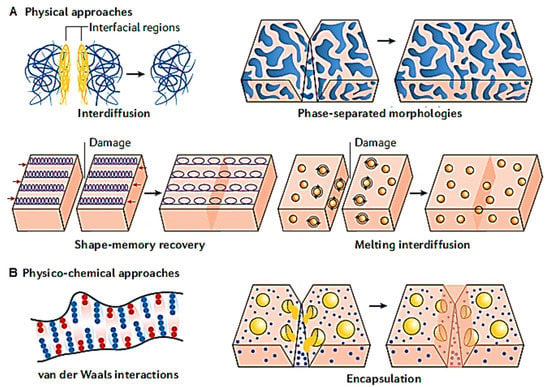
Figure 1.
Self-healing mechanisms: (A) physical processes to understand self-healing include interdiffusion of polymer chains, introduction of phase-separated morphologies, shape-memory and introduction of active nanoparticles into the polymer matrix, and (B) physical and chemical processes can be combined to perceive self-healing. Reprinted with permission from [32]. 2020, Nature.
Physical or covalent interactions at the molecular level have been found to be involved in self-healing of polymers. Usually, physical interactions occur by developing van der Waals forces [44], and chemical interactions mainly comprise covalent interactions [45]. In addition, micro or nanocapsules have been used to initiate the self-recovery process in polymers [46,47]. During self-healing, these capsules rupture in the matrix to heal the damaged surface or area [48].
Jin et al. [49] studied self-healing of epoxy materials using healing agents in the form of microcapsules. (C2H5)2O·BF3 was loaded in the microcapsules. The 1 wt.% (C2H5)2O·BF3-containing microcapsules caused ∼80% self-recovery of impact-related cracked epoxy surface. Epoxy with microcapsules was used as a self-healing adhesive for cohesive failure. The adhesive was applied on the steel surface (Figure 2). According to scanning electron microscopy images, crack tails were observed due to crack-pinning toughening of the fractured sample. On the healed fracture surface, crosslinked polymer film could be observed, initiating the in situ crosslinking of polymer chains for self-healing.
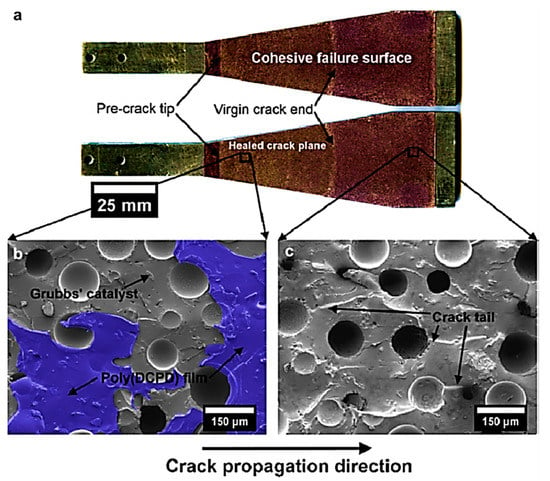
Figure 2.
Quasi-static fracture plane after healing of self-healing specimen: (a) optical images of mating fracture surfaces showing cohesive fracture; (b) SEM image of healed fracture surface showing polymer film (blue) formed during self-healing; and (c) SEM image of fracture surface at end of sample created during imaging (unhealed) revealing crack tails indicative of toughening mechanism SEM = scanning electron microscopy. Reprinted with permission from [49]. 2011, Elsevier.
3. Self-Healing Nanocomposites
Similar to polymers, self-healing polymer-based composites and nanocomposites have been investigated [50]. Self-healing materials have been successfully manufactured for aerospace relevance [51,52]. Self-healing in epoxy/glass fiber composites has been studied via UV curing. Hollow glass fibers were filled with healing agents for damage repair [53,54]. Damage in epoxy/glass fiber composites was self-healed under the influence of UV light and release of healing agent from fibers [55,56]. Moreover, microcapsules with healing agent have been introduced in epoxy composites [57]. In structural aerospace composites, large amounts of healing agent have been required for damage repair. In addition to microcapsules, nanoparticles have also been found to cause the self-healing phenomenon [58]. In aerospace, self-healing nanocomposites have been found to be useful for engineered structures, adhesives, coatings, etc. [59,60]. Self-healing features of epoxy/carbon nanotube nanocomposites have been examined [61]. For self-healing, reversible hydrogen bond formation has been observed between the matrix and nanofiller [62]. The self-healing mechanism was dependent on the polymer chain mobility or effect of external stimuli [63]. Both the physical and covalent interactions have been perceived for the self-healing of thermosets or thermoplastic nanocomposites [64].
4. Self-Healing Nanocomposites for Aerospace
Research on self-healing has continuously grown in last three decades [65,66,67]. Primarily, self-healing polymer/fiber composites were developed [68,69,70]. The self-recovery effect has also been studied for polymeric nanocomposites [71,72]. In nanocomposites, nanofillers have been used to enhance the self-healing effect [73,74,75]. Incidentally, the type of nanofiller and contents have found to be essential factors to initiate the self-healing effect [76]. Here, self-healing agents have also been employed to facilitate the healing process in nanomaterials. To incorporate healing agents, small vesicles or capsules have been used, which may rupture during the recovery of the damaged surface or area [77].
For the aerospace sector, self-healing polymeric nanomaterials have been developed for various purposes such as engineering structures, adhesives, coatings, engines, fuselage, etc. Pulikkalparambil and co-workers [73] designed an epoxy nanocomposite and the self-healing effect was studied using the nano-encapsulated healing agent. The self-healing epoxy nanocomposite was used as a coating to protect the surface damage. Figure 3 exhibits the self-healing mechanism of epoxy coating. During the recovery process, the nanocapsules were burst to release the healing agent for related damage recovery [78]. The damage was almost completely healed using the nanocapsules. Efficient self-healing nanocomposites have been successfully applied in aerospace [79]. The self-healing effect was initiated using various stimuli such as light, heat, moisture, impact, etc. [80]. Space vehicles have been found to be continuously affected by environmental factors. Self-healing of aerospace structures can be caused by external heat, UV radiation, etc., thus preventing possible structural damage effects.
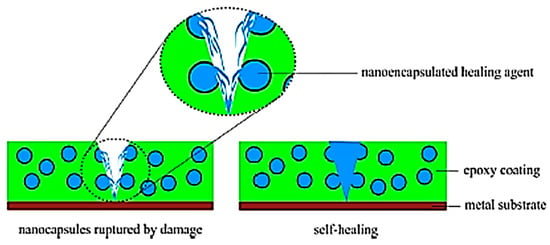
Figure 3.
Self-healing mechanism in polymer nanocomposite using nanocapsules. Reprinted with permission from [73]. 2018, Elsevier.
Zhu and co-workers [81] industrialized aerospace nanocomposites with UV-responsive nanocapsules. The self-healing materials revealed fine performance for aerospace structures facing radiation damages [82,83]. In addition, the nanocapsules caused self-healing of scratched or damaged aerospace structures [84]. Paolillo and co-researchers [23] explored self-healing in epoxy nanomaterials for aerospace. The self-healing mechanism was studied and found to be reliant on reversible physical or chemical crosslinking in the matrix. Polyethylene-co-methacrylic particles were also found to effectively heal the damages in the epoxy matrix [85].
Graphene nanofiller has been used for the self-healing of epoxy materials [86,87]. Graphene is a two-dimensional nanostructure consisting of sp2 hybridized carbon atoms [88]. In 2004, Andre Geim and Konstantin Novoselov prepared and reported single-layer graphene [89]. However, theoretically, graphene was reported earlier in 1947 (P. R. Wallace) and then experimentally explored in 1962 [90]. Graphene revealed excellent structural and physical properties. Self-healing vitrimer epoxy/graphene oxide nanocomposites have been fabricated [91,92,93]. The self-healing features of these nanomaterials were due to the exchangeable covalent network formation in the vitrimer epoxy resin [94]. Krishnakumar and co-workers [95] also studied the self-healing effect in vitrimer/graphene oxide nanocomposites. The self-healing effect was studied at 60 °C. Recovery occurred in 5 min. Inclusion of 0.5–1 wt.% graphene oxide caused 80–88% self-healing of the nanocomposites, relative to the neat epoxy matrix (60–73%). Hu et al. [96] also tested self-healing epoxy/graphene oxide nanocomposites. The epoxy resin was reacted with β-cyclodextrin and azobenzene functional graphene oxide via free radical copolymerization. The self-healing effect was studied through ultraviolet curing and the thermal effect. β-cyclodextrin/azobenzene functional graphene oxide acted as a photothermal agent as well a macro-crosslinking agent. Figure 4 shows the self-healing phenomenon in epoxy nanocomposites with β-cyclodextrin/azobenzene functional graphene oxide. The nanofillers initiated polymer chain mobility in the damaged areas to cause self-healing. In addition, these materials had fine mechanical properties. Table 1 shows the healing efficiency of the epoxy/graphene oxide nanocomposites using both the thermal and photoinduced effects. The photothermal self-healing efficiency was found to be higher than that of the heating effect. The strength recovery rates of the photothermal self-healed samples were also found to be higher than those of the heated samples. In both the effects, self-healing was improved with an increase in time.
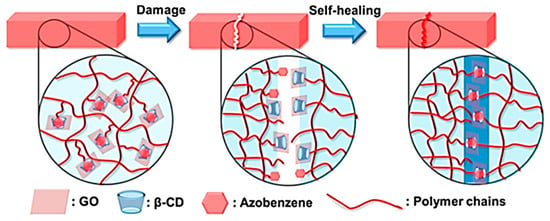
Figure 4.
Schematic illustration of self-healing mechanism of epoxy nanocomposite films. Reprinted with permission from [96]. 2022, ACS.

Table 1.
Heating or photothermal effect triggered self-healing efficiencies of epoxy nanocomposite films at different times EAG = epoxy/functional graphene oxide. Reprinted with permission from [96]. 2022, ACS.
Self-healing polymer/carbon nanotube nanocomposites have been designed for aerospace applications [97]. In the nanomaterials, addition of carbon nanotube may form reversible hydrogen bonding interactions in the polymers [98,99]. Consequently, the self-healing phenomenon relies on damage repair through the bond formation. In addition to physical interactions, functional carbon nanotube may develop covalent bonds with the polymers [100]. Depending on functionalities, carbon nanotube may act as an electron donor or acceptor in relation to polymers for the formation of covalent bonding. Wang et al. [101] fabricated self-healing epoxy/carbon nanotube nanocomposites. The composite laminates consisted of layers of carbon nanotube sheets with intervening layers of carbon fibers. Composite laminates with copper foam sheets were also formed. Carbon-nanotube-based nanosheets have fine nanoparticle dispersion in the laminates [102,103]. Figure 5 shows the healing efficiency of the layered epoxy/carbon nanotube nanocomposite. The nanocomposite with a carbon nanotube nanosheet revealed an average healing efficiency of 107.7% for fracture energy and 96.22% healing efficiency for peak load. Here, the maximum healing efficiency (fracture energy) was 141% for a carbon nanotube nanosheet-based sample. The composite with copper foam sheet had average healing efficiencies of 63.2% (fracture energy) and 58.8% (peak load). The maximum healing efficiency (fracture energy) was 128% for composite with copper foam sheet. The healing efficiency of a carbon-nanosheet-based nanocomposite was found to be much elevated compared to the copper foam sheet material [104,105,106]. An enhanced self-healing effect of the epoxy/carbon nanotube nanocomposite was observed owing to the matrix–nanofiller interactions and interface formation [107].
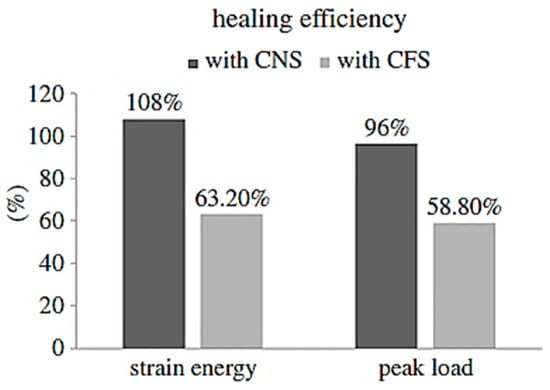
Figure 5.
Healing efficiency of nanocomposites with CNS and CFS nanomaterial. CNS = carbon nanotube nanosheet; CFS = copper foam sheet. Reprinted with permission from [101]. 2016, Royal Society Open Science (Creative Commons Attribution License).
Guadagno and co-workers [108] industrialized epoxy nanocomposites with non-functional carbon nanotube, thymine functional carbon nanotube and barbiturate functional carbon nanotube for aerospace. The structures and interactions of a thymine ligand functional carbon nanotube and epoxy/thymine functional carbon nanotube nanocomposite are given in Figure 6. Hydrogen bonding interactions were observed between C=O and O–H functionalities of epoxy and N–H functionalities of carbon nanotube [109,110]. The formation of reversible interactions was suggested for the self-healing phenomenon in the epoxy nanocomposites. Figure 7 establishes the self-healing efficiency of various nanocomposite samples. Among all nanocomposite samples, 0.5 wt.% contents of thymine functional carbon nanotube led to enhanced self-healing properties due to the existence of reversible hydrogen bonding interactions [111].
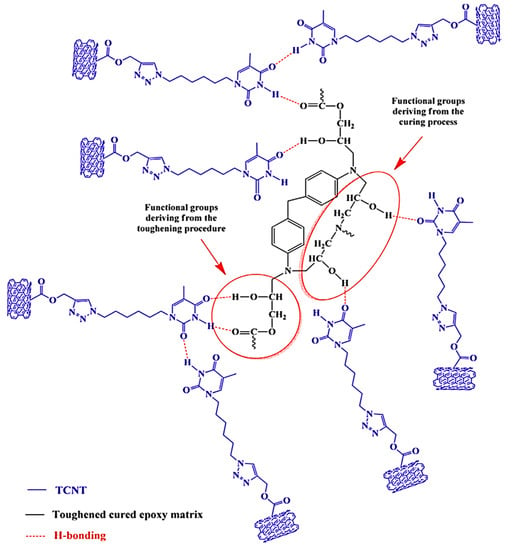
Figure 6.
Representation of supramolecular network generated into the cured sample ETCNT TCNT = carbon nanotube functionalized with thymine; ETCNT = epoxy/carbon nanotube functionalized with thymine-based ligand. Reprinted with permission from [108]. 2021, Elsevier.
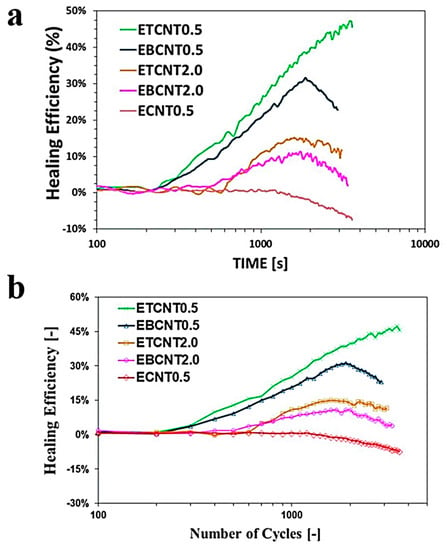
Figure 7.
Self-healing efficiency for the nanocomposite samples containing non-functional CNT (ECNT 0.5 wt.%), thymine functional CNT (ETCNT 0.5 wt.%; ETCNT 2.0 wt.%) and barbiturate functional CNT (EBCNT 0.5 wt.%; EBCNT 2.0 wt.%) as function of: (a) time and (b) number of cycles. ETCNT = epoxy/carbon nanotube functionalized with thymine-based ligand; EBCNT = epoxy/carbon nanotube functionalized with barbituric-acid-based ligands. Reprinted with permission from[108]. 2021, Elsevier.
Guadagno and co-researchers [112] fabricated tetraglycidyl methylene dianiline epoxy (cured with carboxyl-terminated butadiene acrylonitrile, 1,4-butanedioldiglycidylether- and 4,4′-diaminodiphenyl sulfone)-based nanocomposites. The barbiturate functional multiwalled carbon nanotube was used as a nanofiller. A self-healing effect in epoxy nanocomposites was observed due to the inclusion of barbiturate-modified nanofiller [113]. The functional multiwalled carbon nanotube formed reversible hydrogen bonding, causing a self-healing effect in the nanomaterial (Figure 8). Variation in morphology and interfacial regions were also observed for the self-healing nanocomposites. a self-healing phenomenon was observed in the epoxy matrix with 0.5 wt.% of functional as well as non-functional nanofiller. The storage modulus of the epoxy nanocomposites with modified nanofiller and different temperatures has been studied (Figure 9). With increasing temperature from −50 to 120 °C, the storage modulus of the nanocomposites was found to decrease. The addition of modified filler positively affected the storage modulus of the nanocomposite due to the presence of reversible crosslinking in the matrix–nanofiller.
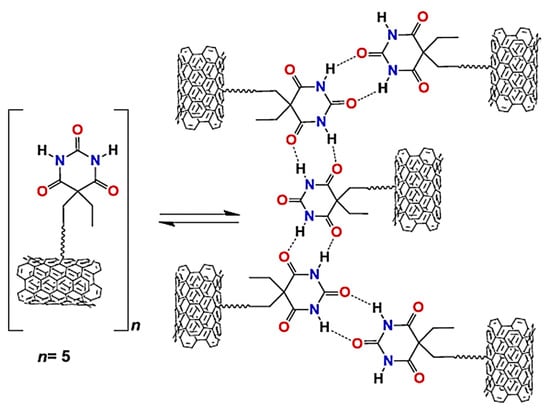
Figure 8.
The barbiturate-modified MWCNT for reversible opening and closing of hydrogen bonds during damage and healing event. MWCNT = multiwalled carbon nanotube. Reprinted with permission from [112]. 2019, Elsevier (Creative Commons CC-BY).
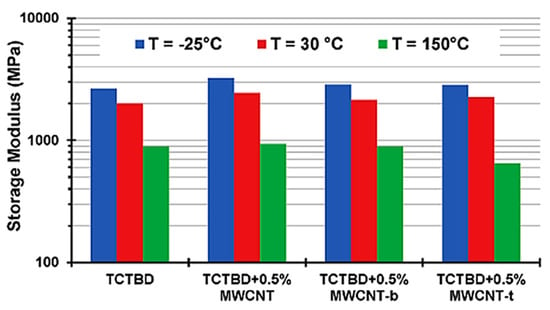
Figure 9.
Storage modulus of nanocomposites at three different temperatures TCTBD = tetraglycidyl methylene dianiline modified with carboxyl-terminated butadiene acrylonitrile, 1,4-butanedioldiglycidylether and 4,4′-diaminodiphenyl sulfone; MWCNT = multiwalled carbon nanotube. Reprinted with permission from [112]. 2019, Elsevier (Creative Commons CC-BY).
5. Significance of Self-Healing Nanocomposites in Space Sector
5.1. Aerospace Engines
Traditionally, engines have been developed using ceramic and metallic materials [114]. Afterward, polymeric materials and composites have been used in high-temperature-resistant jet engine components [115,116]. Moreover, using composite materials has prohibited structural damage related to impact/failure. In turbine blades of engines, composite materials have been successfully used. In the combustion chamber of space vehicle engines, ceramic fibers have the capability to withstand very high temperatures (1000–1350 °C) [117]. Consequently, self-healing nanocomposites have been used to produce fixed and mobile jet engine components [118,119]. In particular, for aerospace combustion chambers, self-healing nanocomposites have been designed [120,121]. In addition to high temperature, pressure, and damage resistance, self-healing nanomaterials revealed corrosion resistance properties for engine components [122]. The superior properties of self-healing nanocomposites have enhanced the efficiency of turbine engines [123]. Tong et al. [124] proposed nanomaterials for the compressor casing of aero engines or gas turbines to attain high efficiency and low fuel consumption. Using self-healing materials enhanced the scratch force to resist blade vibrations and engine jams. Epoxy-based materials with 31 wt.% hollow microspheres possess high bonding strength. However, such materials may have 63% porosity and a hardness of 33. Figure 10 shows features of pristine material and material after use in an engine. Porosity was found to increase in the material. The tensile fracture crack was found to propagate with a large diameter.
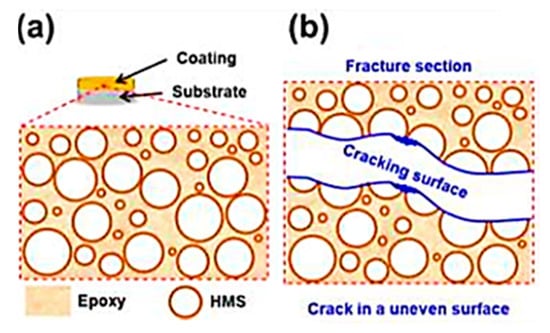
Figure 10.
Schematic diagram of (a) original material and (b) tensile fracture surface after use in engine. HMS = phenolic resin hollow microspheres. Reprinted with permission from [124]. 2021, Elsevier.
5.2. Space Structures
Self-healing nanocomposites have been scrutinized for aerospace structures [125,126]. In high-performance aerospace structural parts, self-healing fiber-reinforced composites have been applied [127]. The composite materials have an aptitude for capably healing micro cracks and fatigue damage. In addition to self-healing, these materials have superior mechanical features for aerospace structures. Aerospace-grade laminates have been developed using self-healing epoxy/E-glass fiber composites.
The self-healing epoxy/carbon fiber laminates have also been used for aerospace structures [128]. Moreover, healing agents have been used to enhance the self-healing efficiency of epoxy-based space materials. For example, formaldehyde/urea microcapsules have been used as healing agents for diglycidyl ether of an bisphenol A epoxy matrix [129]. The epoxy matrix was found to be reversibly crosslinked during self-healing, with the help of micro- or nanocapsules. In this way, efficient reformation of matrix cracks has been observed to regain the structural integrity. Kessler and co-researchers [130] fabricated self-healing Bisphenol A diglycidyl ether epoxy-based materials. Scanning electron micrographs of fracture surfaces of self-healing materials are given in Figure 11. In a delaminated matrix, self-healing agent can be observed to be bridging the matrix strands for the self-healing process. The loading curves of neat and healed samples are given in Figure 12. Self-healing was observed at 80 °C (48 h). For the self-healed sample, crack propagation was less prominent relative to the neat epoxy sample. Prominent crack development mid-plane was observed for pristine epoxy material. Thus, self-healing epoxy, epoxy/nanocarbon nanomaterials and polymer/carbon fiber/nanocarbon nanocomposites have been exploited for aircraft and space vehicles [131].
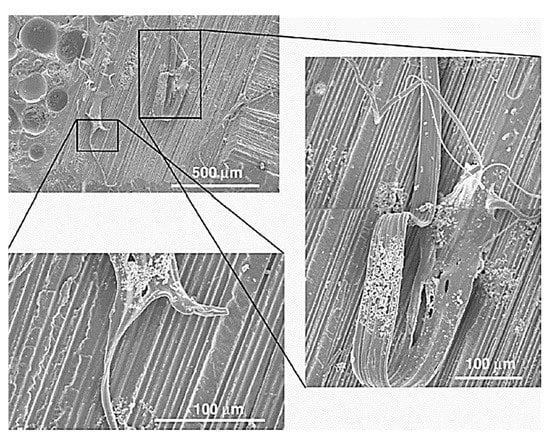
Figure 11.
Scanning electron microscopy images of healed fracture surfaces of self-healing sample (30 min healing time). Reprinted with permission from [130]. 2003, Elsevier.
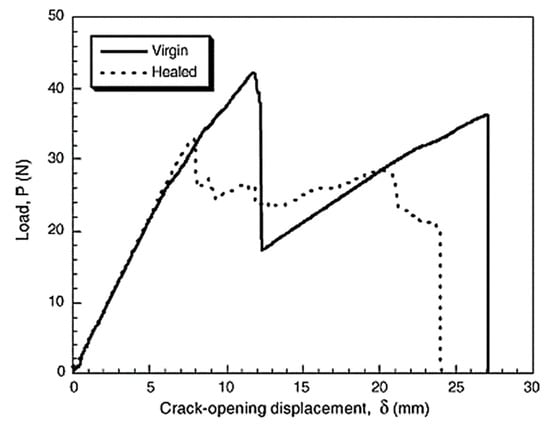
Figure 12.
Typical loading curves of pristine and healed self-healing samples (note: healing conditions = 48 h at 80 °C). Reprinted with permission from [130]. 2003, Elsevier.
Self-healing ability of materials have been achieved at the cost of sacrificing their mechanical properties. Williams et al. [132] designed epoxy/carbon fiber/hollow glass fiber composites. Inclusion of glass fibers caused flexural strength recovery of 97%. However, the mechanical recovery was reduced in repeated testing. A reduction in flexural strength of the healed samples is given in Table 2. Flexural analysis showed that damaged and healed samples revealed considerable reduction in flexural strength relative to undamaged samples. This effect was attributed to significant variation in fiber architecture after healing. Effects of healing components on epoxy composite structures for aerospace structural applications have been scrutinized [133]. The DGEBA/carbon composite with microcapsules, with a healing agent and catalyst, revealed reduced mechanical properties. The mechanical properties of composites without a healing agent and catalyst were decreased. However, fine recovery of mechanical properties was attained with healing agents. Teoh et al. [134] proposed a self-healing epoxy composite with a healing agent for aerospace structures. The specimens were damaged by indentation, and three-point bend flexural tests were applied. After self-healing, good strength recovery was observed. Epoxy composites with E-glass fiber have been used to form aerospace structures [135]. Toohey et al. [136] developed an epoxy/fiber-based self-healing system showing autonomous repair after repeated damage events. The healing agent was delivered into cracks of materials, which formed a three-dimensional microvascular network. The release of healing agent caused bubbles in the structure (Figure 13). The healing efficiency was found to be up to 70–80%. After repeated damage, 40% healing was observed.

Table 2.
Results of flexural four-point bend testing of aerospace composites. Reprinted with permission from [132]. 2007, Elsevier.
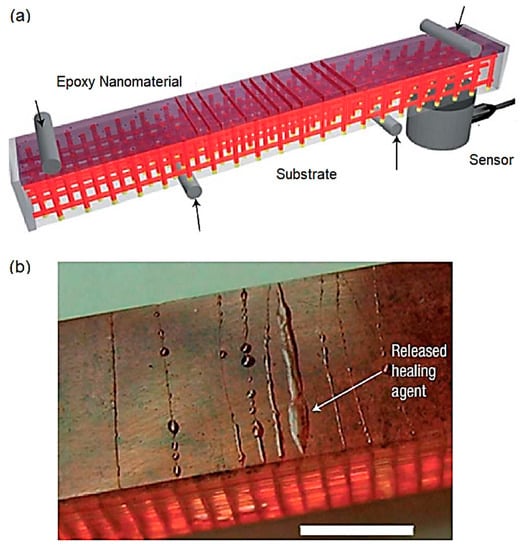
Figure 13.
(a) Schematic of microvascular substrate; (b) optical image of actual microvascular system after damage. Reprinted with permission from [136]. 2007, Nature.
5.3. Aerospace Fuselage
An important use of polymer/fiber composites has been experiential for aerospace fuselage [137]. Here, the epoxy/carbon fiber composites and epoxy/glass fiber composites have been operated [138,139]. In particular, these materials have been utilized in fuselage of civil and military crafts and aerospace structures. In fuselage, self-healing composites have been found to have the scope to overcome load, fracture, fatigue, impact and sustainability issues [140,141]. In this regard, self-healing epoxy/carbon fiber/carbon nanotube nanocomposites have been used to develop aerospace-grade fuselage [142]. Inclusion of nanoparticles such as carbon nanotube and graphene may further enhance the impact resistance of epoxy/fiber nanocomposites. The fuselage materials have the capability to self-heal various damage to the main body parts of aircraft. Relative to metal alloy-based structures, a healing efficiency of >90% has been observed for self-healing polymer nanocomposites. Consequently, metal-based space fuselage has been successfully replaced with the composite structures with superior damage-healing properties [143].
Studies have focused on analyzing impact and mechanical properties of epoxy/carbon fiber self-healing composites [144]. Bond et al. [145] prepared self-healing epoxy/carbon fiber laminates to overcome impact resistance. The flexural strength of a 16-ply aerospace-grade composite with hollow glass fibers was investigated. A 97% strength recovery was observed after quasistatic indentation damage. The epoxy/glass fiber composites have been used in aerospace fuselage as self-healing composites, with 92% recovery or healing observed after impact damage. To further improve impact properties of self-healing epoxy/glass fiber or epoxy/carbon fiber composites for aerospace applications, super-elastic self-healing NiTi alloy wires were used along with carbon or glass fiber fillers. The stacking sequences of fiber laminates and resin have been designed for this purpose. Inclusion of self-healing wires enhanced the damage tolerance of aerospace composites under repeated impacts. Self-healing polymer composites have been investigated as an alternative to metal alloys for protecting space structures from space debris [146]. Figure 14 shows a turbo-electric propulsive fuselage aircraft design developed in a concept validation study for fuselage wake-filling propulsion integration (CENTRELINE) [147]. It has twin-engine, turbo-electric systems, a fuselage fan powered through a generator, and geared turbofan power plants podded under the wings. The fuselage internal thermal shielding requirements and internal/external noise and vibration were reduced by using advanced self-healing nanocomposites. Figure 15 shows that the maximum vertical displacement at the fuselage tip remains within 57 mm. More than 60% loads caused local wrinkling. The study indicated that using self-healing nanomaterials caused structural safety and buckling resistance. Thus, the load-carrying capability was enhanced using an advanced structural design concept.

Figure 14.
Turbo-electric propulsive fuselage aircraft design. Reprinted with permission from [147]. 2021, MDPI.
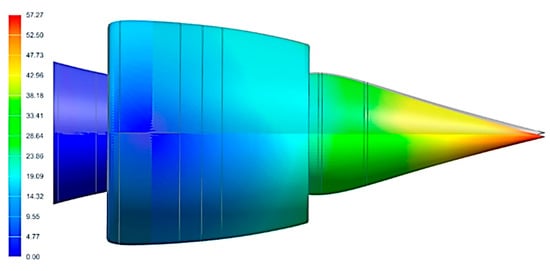
Figure 15.
Displacement map for fuselage nacelle and integration structure under load. Reprinted with permission from [147]. 2021, MDPI.
Nonstructural aircraft parts such as seals and gaskets employ elastomer-based materials with high flexibility and elasticity [148]. These materials have low density, high ductility, moderate cost and corrosion resistance. Thermosets have not been used in seals and gaskets. Nevertheless, polymer composites have been preferred in these applications. Some research has been conducted on self-healing materials consisting of polymer and natural fibers for gaskets [149]. However, future research is desirable to expand this field.
5.4. Coatings/Adhesives
Coatings for metallic alloys such as aluminum, titanium and magnesium are importance for civil and military aircrafts because such structures need corrosion protection. Self-healing coatings and adhesives have been focused for aerospace structures [150]. The self-healing coatings and adhesives may efficiently heal the damage of substrates [151,152]. In particular, anticorrosion coatings may easily self-heal corrosion damage. Yang and co-workers [153] developed self-healing epoxy coatings with urea formaldehyde microcapsules. The coatings were applied on the aerospace-grade aluminum surface [154,155,156,157]. Similarly, epoxy nanocomposite adhesives have been applied to heal aerospace structural damage [158]. Self-healing epoxy/graphene nanocomposite-based adhesives have been effectually reported for space structures [159,160,161]. Adhesives and coatings have been used to cure and prevent aerospace structural damage in primary and secondary structures of aircrafts, helicopters, aero-engines and spacecraft components [162]. For inspection of large aerospace components, infrared thermography has been efficiently used as a rapid and accurate non-destructive means of evaluation (Figure 16). This method can measure and analyze damage to aluminum, composites and hybrid fiber metal laminates such as carbon-reinforced aluminum laminate and carbon/glass fiber-filled aluminum and epoxy laminates. Material defects may occur at any stage of component usage or cyclic life. Infrared thermography has detected and quantify the material flaws from manufacturing to in-service or maintenance operations. Almost all materials and components can be analyzed using an infrared thermography technique. Studies have depicted that few designs have been studied so far for aerospace adhesives and more research efforts are needed to design innovative coatings and adhesives for aerospace. Meure and co-workers [163] formed self-healing epoxy materials with polyethylene-co-methacrylic acid particles in adhesive. Figure 17 shows fractured and healed epoxy system with polyethylene-co-methacrylic acid particles. Healing was observed at 150 °C. Polyethylene-co-methacrylic acid caused a pressure-driven healing mechanism of the epoxy system. Inclusion of nanocapsules enhanced complete damage recovery during self-healing. The nanocapsules burst and released a healing agent for damage recovery. Therefore, efficient self-healing nanocomposites have been applied in aerospace structures. The self-healing materials help to recover aircraft structures that have experienced damage due to heat cycles, UV radiation, atomic oxygen, space debris, etc. [164].

Figure 16.
Illustration of typical material defects monitored by IRT for composite aircraft and spacecraft structures (a); jet engine turbine blades (b); honeycomb panels (c) and metallic aircraft and spacecraft components (d). Reprinted with permission from [162]. 2018, MDPI.
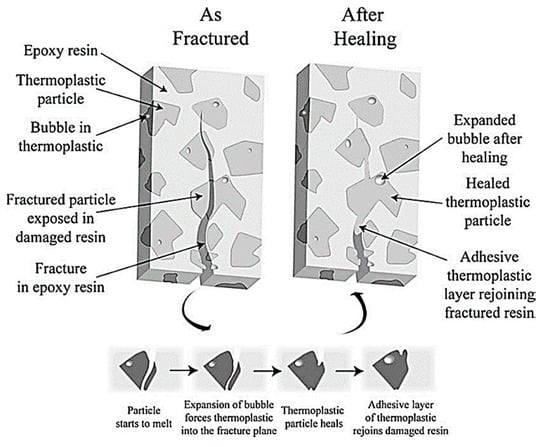
Figure 17.
Schematic of healing agent delivery mechanism in epoxy-resin-containing healing agent containing particles in adhesives. EMAA = polyethylene-co-methacrylic acid. Reprinted with permission from [163]. 2009, Elsevier.
6. Mechanism of Self-Healing in Space Nanocomposites
The self-healing phenomena in these nanocomposites have been found to operate through various mechanisms [19]. These mechanisms can repair the damage to structures [165]. Depending on the capability of self-healing materials, they are often referred to as intrinsic or extrinsic self-healing materials. Intrinsic self-healing polymers undergo dynamic covalent chemistry and non-covalent chemistry using secondary interactions (Figure 18) [166]. Intrinsic self-healing is usually triggered by external stimuli such as temperature, light, pressure, pH, etc. The healing may occur through multiple cycles without using any catalyst. However, intrinsic self-healing may have disadvantage that it is restricted to thermoplastic polymers that develop weak bonds, which decrease strength. The extrinsic healing process relies on using healing agent as a phase in the polymer matrix [167]. In this regard, the healing agent can be used as a liquid component. For such healing agents, microcapsules or hollow fibers have usually been filled with liquid compound [168]. In some cases, healing agents in liquid form can be directly incorporated in polymeric matrices to induce self-healing effects. Here, healing agent can be mixed with a catalyst and included in polymers for better recovery properties. Sometimes, catalysts can also be filled in microcapsules or hollow fibers along with the healing agents [169].
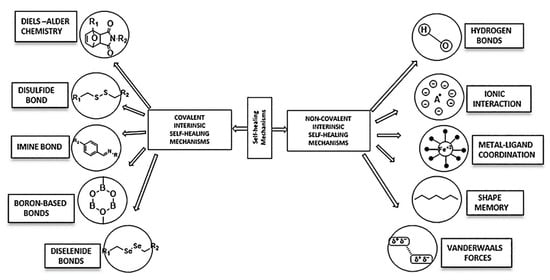
Figure 18.
Covalent and non-covalent intrinsic mechanisms. Reprinted with permission from [165]. 2022, Wiley.
When any damage occurs to an aerospace structure, these microcapsules or hollow fibers break down to release the encapsulated healing agent and catalyst. The released healing agent not only heals the existing cracks but also prevents further crack growth through its action. Consequently, the fracture failure of the space structure has been recovered. Using efficient healing agent, which itself reacts to recover the damage, means there is no need to add a catalyst as an additional component. Accordingly, catalysts do not initiate the healing process of the damaged structures. It is important to mention that the shape of the container used (capsule or tube) containing the healing agent does not influence the recovery process. Nevertheless, the type of healing compound used governs the recovery process. When damage occurs, the hollow containers with compounds break down and healing agent is released and delivered to the cracks. Thus, the extrinsic healing mechanism operates through the response upon the onset of any damage. Additionally, self-healing materials employing extrinsic methods are susceptible to repeated damage. The healing agents released from the containers can only act a single time and then containers become empty. Then, further healing of structures is not possible if there is repeated damage. Another extrinsic self-healing approach is the use of nanofillers in the nanocomposites, which may trigger the recovery process, instead of using encapsuled healing agents. In the case of self-healing nanocomposites, nanofillers such as graphene and carbon nanotube may cause healing of the damaged surface [170]. Research must focus on the modification of healing agents and catalysts used and also the release mechanism of these compounds under damage. Moreover, recovery effects using nanoparticles need to be investigated in detail so that the use of healing agents can be avoided in the case of polymeric nanocomposites.
Hence, self-healing polymeric materials and nanocomposites possess several promising aspects for aerospace structures. However, their utilization in real-world applications obviously needs a high level of durability, mechanical stability and thermal performance. Use of a few self-healing materials in real aircraft has been described in the fuselage, engine and aerospace structure (Section 5). The nature of thermosets, thermoplastics, elastomers, nanofiller type and healing agent plays a crucial role in ensuring spacecraft safety. However, up till now, no universal standards have been developed for determining the self-healing properties of aerospace structures. Moreover, comparative studies have not been performed on the applicability of self-healing materials for aerospace applications. This has limited the real applications of self-healing materials in the aerospace industry. There is a need to develop standard protocols for estimating self-healing features of materials for space structures. Without standard protocols, large-scale industrial applications and scalability of self-healing materials are limited. Novel self-healing designs also need to be developed with specific functionalities for particular applications.
On the other hand, intrinsic healing follows quite a different mechanism for damage recovery compared to the extrinsic self-healing process [171]. In intrinsic healing, the inherent properties of nanocomposite materials have been considered important. In this case, external addition of a healing compound containing vesicles is not required. The particular material properties include chemical bonding, physical interactions and molecular structural variations [172]. Intrinsic self-healing usually necessitates using an external stimulus for damage recovery. Mostly, high-temperature conditions have been used to initiate the intrinsic healing process [173]. However, in some cases, external stimuli are not required to initiate the self-healing phenomenon; instead, the process intrinsically occurs upon a damage event. The mechanism of intrinsic self-healing operates through supramolecular chemistry, formation of reversible covalent bonds and also the development of thermos-reversible physical interactions [172]. The reversible covalent linking mechanism functions through reversible bond formation under damaging conditions. The mechanism of physical interactions also functions through the formation of reversible crosslinks at the damaged areas. The reversible physical interactions are usually low-energy interactions, which may influence the healing and physical properties of the nanomaterials. Upon damage, self-healing occurs by reformation of interactions and damage recovery. Thus, the general mechanism of intrinsic self-healing works on the basis of reversible interactions in the polymers or nanocomposite structures.
It is important to understand the relationship between the mechanical properties and self-healing capabilities of the materials. Table 3 demonstrates the processing, self-healing and mechanical performance of the nanocomposite systems. The self-healing processes of polymers and nanomaterials depend upon surface rearrangement, surface approach, wetting, diffusion and randomization [174]. These factors affect the chain mobility, exchange rate of network structure and nature of reversible chemistry. Usually, the more dynamic the reversible chemistry, the better the self-healing ability of the material. Here, low association strength of reversible chemistry causes good self-healing ability of polymers. However, the low association strength of a reversible self-healing network does not allow it to resist external forces. Therefore, reversible chemistry endows polymers with fine self-healing capability, but less resistance to external forces. Accordingly, better reversible chemistry decreases the attainment of high tensile strength of materials during potential applications. Consequently, producing self-healing materials that not only have high mechanical properties but also high self-healing efficiency is challenging. In this regard, various strategies have been adopted such as nanofiller addition, phase separation, multi-networks and sacrificial bonds to form self-healing materials with high tensile strength and fracture toughness. It has been observed that incorporating nanofillers into materials may dissipate large amounts of energy through reversible bond rupture, leading to a combination of high mechanical and self-healing properties. Inclusion of nanofillers may promote sacrificial bonding, reversible hydrogen bonding interactions, ionic interactions, etc. Covalent self-healing polymeric nanocomposites with nanofillers and sacrificial bonds have also been developed. Hence, the mechanical performance of a non-covalent or covalent self-healing network can be enhanced through nanofiller inclusion and sacrificial bond formation.

Table 3.
Design, processing, self-healing and mechanical properties of aerospace nanocomposites.
7. Prospects and Conclusions
The potential of self-healing nanocomposites has been researched for aeronautical structures [179,180]. Different thermosets and thermoplastics have been used to develop the self-healing nanocomposites [181]. In polymers, the inclusion of nanoparticles has enhanced the self-healing effect [182], in addition to the mechanical properties [183,184]. Special self-healing effects have been observed to reconcile the rusting, impact and ecological influences. Advanced self-healing aerospace structural designs have been found to be indispensable for future progression in this field [185]. In the future, self-healing polymer/nanocarbon nanocomposites can be developed for damage sensing in aerospace structures [186,187]. In aerospace, self-healing materials can be beneficial for desirable electronic components such as batteries, circuits, sensors, supercapacitors, etc. [188,189]. Novel healing agents based on nanocapsules and nanocarbon nanoparticles need to be designed with superior self-healing efficiency under high temperature, pressure and impact conditions. Such materials may enhance the durability of future space structures [190]. However, it is still challenging to replace whole spacecraft parts with self-healing composite [191]. Similarly, the use of ecofriendly self-healing materials based on sustainable polymers can be a research focus for future efficient aerospace structures.
In short, this review article highlights the fundamentals and potential of self-healing composites/nanocomposites for aerospace structural components. The self-healing effect can be produced intrinsically or by using nanocapsules, nanotubes, nanofibers, vesicles or nanocarbon nanoparticles. Literature studies have shown that self-healing polymers are promising materials for repairing structural damage, cracks and defects. These materials have remarkable mechanical, thermal and other physical features for industrial applications. Self-healing nanocomposites have also been used to recover damage related to the strength, impact, fatigue, cracks, corrosion and environment. This overview particularly covers self-healing materials for aeronautical applications. Investigations have been carried out to analyze the improvements in crack properties of space structures. Consequently, self-healing nanocomposites have been utilized for various aerospace structures, engines, fuselage, coatings and adhesives. The mechanisms involved in self-healing also enhance the healing efficiency and life cycle of these materials. During different phases of self-healing, materials have been scrutinized to achieve long-time service life. The performance properties of self-healing materials have been improved by the inclusion of nanoparticles. More advanced healing techniques have been proposed in literature studies to extend beyond the intrinsic and extrinsic mechanisms and overcome the challenges involved in fabrication and performance of self-healing materials. More emerging polymeric nanomaterials must also be explored for the aerospace sector. However, studies on aerospace materials are still in progress and further novel developments are needed.
Author Contributions
Conceptualization, A.K.; data curation, A.K.; writing—original draft preparation, A.K.; review and editing, A.K., I.A., M.M. and P.B. All authors have read and agreed to the published version of the manuscript.
Funding
This research received no external funding.
Data Availability Statement
Not applicable.
Conflicts of Interest
The authors declare no conflict of interest.
References
- Kordas, G. All-Purpose Nano-and Microcontainers: A Review of the New Engineering Possibilities. Eng 2022, 3, 554–572. [Google Scholar] [CrossRef]
- Reddy, K.R.; El-Zein, A.; Airey, D.W.; Alonso-Marroquin, F.; Schubel, P.; Manalo, A. Self-healing polymers: Synthesis methods and applications. Nano-Struct. Nano-Objects 2020, 23, 100500. [Google Scholar] [CrossRef]
- Nauman, S. Piezoresistive sensing approaches for structural health monitoring of polymer composites—A review. Eng 2021, 2, 197–226. [Google Scholar] [CrossRef]
- Kaddaha, M.A.; Younes, R.; Lafon, P. Homogenization method to calculate the stiffness matrix of laminated composites. Eng 2021, 2, 416–434. [Google Scholar] [CrossRef]
- Dong, W.; Li, W.; Shen, L.; Zhang, S.; Vessalas, K. Integrated self-sensing and self-healing cementitious composite with microencapsulation of nano-carbon black and slaked lime. Mater. Lett. 2021, 282, 128834. [Google Scholar] [CrossRef]
- Liu, D.; Fan, C.J.; Xiao, Y.; Yang, K.K.; Wang, Y.Z. High strength, self-healing polyurethane elastomer based on synergistic multiple dynamic interactions in multiphase. Polymer 2022, 263, 125513. [Google Scholar] [CrossRef]
- Peng, Y.; Guo, Z. Recent advances in biomimetic thin membranes applied in emulsified oil/water separation. J. Mater. Chem. A 2016, 4, 15749–15770. [Google Scholar] [CrossRef]
- Yabuki, A.; Fathona, I.W. Self-healing corrosion protective coatings in transportation industries. In Advances in Smart Coatings and Thin Films for Future Industrial and Biomedical Engineering Applications; Elsevier: Amsterdam, The Netherlands, 2020; pp. 99–133. [Google Scholar]
- Mhlanga, N.; Mphahlele, K. Self-healing Substrates: Fabrication, Properties and Applications. In Self-Standing Substrates; Springer: Berlin/Heidelberg, Germany, 2020; pp. 235–267. [Google Scholar]
- Coope, T.S.; Turkenburg, D.H.; Fischer, H.R.; Luterbacher, R.; Van Bracht, H.; Bond, I.P. Novel Diels-Alder based self-healing epoxies for aerospace composites. Smart Mater. Struct. 2016, 25, 084010. [Google Scholar] [CrossRef]
- Van Mullem, T.; Gruyaert, E.; Caspeele, R.; De Belie, N. First large scale application with self-healing concrete in belgium: Analysis of the laboratory control tests. Materials 2020, 13, 997. [Google Scholar] [CrossRef]
- Tan, Y.J.; Susanto, G.J.; Anwar Ali, H.P.; Tee, B.C. Progress and Roadmap for Intelligent Self-Healing Materials in Autonomous Robotics. Adv. Mater. 2021, 33, 2002800. [Google Scholar] [CrossRef]
- Chalapathi, K.V.; Prabhakar, M.; Lee, D.-W.; Song, J.-i. Development of thermoplastic self-healing panels by 3D printing technology and study extrinsic healing system under low-velocity impact analysis. Polym. Test. 2023, 119, 107923. [Google Scholar] [CrossRef]
- Zhang, F.; Zhang, L.; Yaseen, M.; Huang, K. A review on the self-healing ability of epoxy polymers. J. Appl. Polym. Sci. 2021, 138, 50260. [Google Scholar] [CrossRef]
- Utrera-Barrios, S.; Verdejo, R.; López-Manchado, M.Á.; Santana, M.H. The final frontier of sustainable materials: Current developments in self-healing elastomers. Int. J. Mol. Sci. 2022, 23, 4757. [Google Scholar] [CrossRef] [PubMed]
- Liu, X.; Zhang, E.; Liu, J.; Qin, J.; Wu, M.; Yang, C.; Liang, L. Self-healing, reprocessable, degradable, thermadapt shape memory multifunctional polymers based on dynamic imine bonds and their application in nondestructively recyclable carbon fiber composites. Chem. Eng. J. 2023, 454, 139992. [Google Scholar] [CrossRef]
- Kim, Y.N.; Jeong, H.; Ryu, S.; Jung, Y.C. Self-Healing Polymers and Composites for Additive Manufacturing: Materials, Properties, and Applications. In Nanotechnology-Based Additive Manufacturing: Product Design, Properties and Applications; Wiley Online Library: New York, NY, USA, 2023; Volume 1, pp. 219–248. [Google Scholar]
- Fatahi, A.; Mohammadi, A.; Sarfjoo, M.R. 16 Polymers for Smart Coatings. In Specialty Polymers: Fundamentals, Properties, Applications and Advances; CRC Press: Boca Raton, FL, USA, 2023; p. 233. [Google Scholar]
- Pezzin, S.H. Mechanism of Extrinsic and Intrinsic Self-healing in Polymer Systems. In Multifunctional Epoxy Resins: Self-Healing, Thermally and Electrically Conductive Resins; Springer: Berlin/Heidelberg, Germany, 2023; pp. 107–138. [Google Scholar]
- Klingler, W.W.; Bifulco, A.; Polisi, C.; Huang, Z.; Gaan, S. Recyclable inherently flame-retardant thermosets: Chemistry, properties and applications. Compos. Part B Eng. 2023, 110667. [Google Scholar] [CrossRef]
- Parameswaran, B.; Singha, N.K. Self-Healing Composites: Capsule-and Vascular-Based Extrinsic Self-Healing Systems. In Toughened Composites; CRC Press: Boca Raton, FL, USA, 2022; pp. 203–216. [Google Scholar]
- Wemyss, A.M.; Ellingford, C.; Morishita, Y.; Bowen, C.; Wan, C. Dynamic polymer networks: A new avenue towards sustainable and advanced soft machines. Angew. Chem. Int. Ed. 2021, 60, 13725–13736. [Google Scholar] [CrossRef]
- Paolillo, S.; Bose, R.K.; Santana, M.H.; Grande, A.M. Intrinsic self-healing epoxies in polymer matrix composites (PMCs) for aerospace applications. Polymers 2021, 13, 201. [Google Scholar] [CrossRef] [PubMed]
- Ekeocha, J.; Ellingford, C.; Pan, M.; Wemyss, A.M.; Bowen, C.; Wan, C. Challenges and Opportunities of Self-Healing Polymers and Devices for Extreme and Hostile Environments. Adv. Mater. 2021, 33, 2008052. [Google Scholar] [CrossRef]
- Aly, A.A.; Zeidan, E.-S.B.; Alshennawy, A.A.; El-Masry, A.A.; Wasel, W.A. Friction and wear of polymer composites filled by nano-particles: A review. World J. Nano Sci. Eng. 2012, 2, 32. [Google Scholar] [CrossRef]
- Sahmaran, M.; Yildirim, G.; Erdem, T.K. Self-healing capability of cementitious composites incorporating different supplementary cementitious materials. Cem. Concr. Compos. 2013, 35, 89–101. [Google Scholar] [CrossRef]
- Ramesh, M.; Kumar, L.R.; Khan, A.; Asiri, A.M. Self-healing polymer composites and its chemistry. In Self-Healing Composite Materials; Elsevier: Amsterdam, The Netherlands, 2020; pp. 415–427. [Google Scholar]
- Khan, M.; Shah, L.A.; Khan, M.A.; Khattak, N.S.; Zhao, H. Synthesis of an un-modified gum arabic and acrylic acid based physically cross-linked hydrogels with high mechanical, self-sustainable and self-healable performance. Mater. Sci. Eng. C 2020, 116, 111278. [Google Scholar] [CrossRef] [PubMed]
- Jiang, J.; Guan, Q.; Liu, Y.; Sun, X.; Wen, Z. Abrasion and Fracture Self-Healable Triboelectric Nanogenerator with Ultrahigh Stretchability and Long-Term Durability. Adv. Funct. Mater. 2021, 31, 2105380. [Google Scholar] [CrossRef]
- Ouni, S.; Askri, D.; Jeljeli, M.; Abdelmalek, H.; Sakly, M.; Amara, S. Toxicity and effects of copper oxide nanoparticles on cognitive performances in rats. Arch. Environ. Occup. Health 2019, 75, 384–394. [Google Scholar] [CrossRef]
- Feng, X.; Li, G. Room-Temperature Self-Healable and Mechanically Robust Thermoset Polymers for Healing Delamination and Recycling Carbon Fibers. ACS Appl. Mater. Interfaces 2021, 13, 53099–53110. [Google Scholar] [CrossRef] [PubMed]
- Wang, S.; Urban, M.W. Self-healing polymers. Nat. Rev. Mater. 2020, 5, 562–583. [Google Scholar] [CrossRef]
- Erice, A.; de Luzuriaga, A.R.; Azcune, I.; Fernandez, M.; Calafel, I.; Grande, H.-J.; Rekondo, A. New injectable and self-healable thermoset polythiourethane based on S-aromatic thiourethane dissociative exchange mechanism. Polymer 2020, 196, 122461. [Google Scholar] [CrossRef]
- Jeong, Y.J.; Jung, J.; Suh, E.H.; Yun, D.J.; Oh, J.G.; Jang, J. Self-healable and stretchable organic thermoelectric materials: Electrically percolated polymer nanowires embedded in thermoplastic elastomer matrix. Adv. Funct. Mater. 2020, 30, 1905809. [Google Scholar] [CrossRef]
- Xie, J.; Fan, L.; Yao, D.; Su, F.; Mu, Z.; Zheng, Y. Ultra-robust, self-healable and recyclable polyurethane elastomer via a combination of hydrogen bonds, dynamic chemistry, and microphase separation. Mater. Today Chem. 2022, 23, 100708. [Google Scholar] [CrossRef]
- Liu, M.; Zhong, J.; Li, Z.; Rong, J.; Yang, K.; Zhou, J.; Shen, L.; Gao, F.; Huang, X.; He, H. A high stiffness and self-healable polyurethane based on disulfide bonds and hydrogen bonding. Eur. Polym. J. 2020, 124, 109475. [Google Scholar] [CrossRef]
- Gao, D.; Zhang, J.; Lyu, B.; Ma, J.; Yang, Z. Polyacrylate crosslinked with furyl alcohol grafting bismaleimide: A self-healing polymer coating. Prog. Org. Coat. 2020, 139, 105475. [Google Scholar] [CrossRef]
- Lin, C.; Ge, H.; Wang, T.; Huang, M.; Ying, P.; Zhang, P.; Wu, J.; Ren, S.; Levchenko, V. A self-healing and recyclable polyurethane/halloysite nanocomposite based on thermoreversible Diels-Alder reaction. Polymer 2020, 206, 122894. [Google Scholar] [CrossRef]
- Postiglione, G.; Turri, S.; Levi, M. Effect of the plasticizer on the self-healing properties of a polymer coating based on the thermoreversible Diels–Alder reaction. Prog. Org. Coat. 2015, 78, 526–531. [Google Scholar] [CrossRef]
- Cui, J.; Ma, Z.; Pan, L.; An, C.-H.; Liu, J.; Zhou, Y.-F.; Li, Y.-S. Self-healable gradient copolymers. Mater. Chem. Front. 2019, 3, 464–471. [Google Scholar] [CrossRef]
- Hao, S.; Li, T.; Yang, X.; Song, H. Ultrastretchable, Adhesive, Fast Self-Healable, and Three-Dimensional Printable Photoluminescent Ionic Skin Based on Hybrid Network Ionogels. ACS Appl. Mater. Interfaces 2021, 14, 2029–2037. [Google Scholar] [CrossRef] [PubMed]
- Liu, Q.; Li, L.; Urban, M.W. Probing Molecular Events in Self-Healable Polymers. Spectrosc. Tech. Polym. Charact. Methods Instrum. Appl. 2021, 345–366. [Google Scholar] [CrossRef]
- Wang, D.; Ren, S.; Chen, J.; Li, Y.; Wang, Z.; Xu, J.; Jia, X.; Fu, J. Healable, highly thermal conductive, flexible polymer composite with excellent mechanical properties and multiple functionalities. Chem. Eng. J. 2021, 430, 133163. [Google Scholar] [CrossRef]
- Kasak, P.; Hrobárik, P.; Osička, J.; Soláriková, D.; Horváth, B.; Tkac, J.; Sadasivuni, K.K.; AlMaadeed, M.A.; Mikláš, R. Nicotinamide-based supergelator self-assembling via asymmetric hydrogen bonding NH⋯ OC and H⋯ Br− pattern for reusable, moldable and self-healable nontoxic fuel gels. J. Colloid Interface Sci. 2021, 603, 182–190. [Google Scholar] [CrossRef]
- Kee, J.; Ahn, H.; Park, H.; Seo, Y.-S.; Yeo, Y.H.; Park, W.H.; Koo, J. Stretchable and Self-Healable Poly (styrene-co-acrylonitrile) Elastomer with Metal–Ligand Coordination Complexes. Langmuir 2021, 37, 13998–14005. [Google Scholar] [CrossRef]
- Bahrani, S.; Mousavi, S.M.; Hashemi, S.A.; Lai, C.W.; Chiang, W.H. Self-Healable Core–Shell Nanofibers. Self-Health Smart Mater. Allied Appl. 2021, 181–202. [Google Scholar] [CrossRef]
- Lee, K.; Cavazos, C.G.; Rouse, J.; Wei, X.; Li, M.; Wei, S. Advanced Micro/Nanocapsules for Self-healing Smart Anticorrosion Coatings: A Review of Recent Developments. In Corrosion Protection of Metals and Alloys Using Graphene and Biopolymer Based Nanocomposites; 2021; pp. 169–190. Available online: https://www.taylorfrancis.com/chapters/edit/10.1201/9781315171364-12/advanced-micro-nanocapsules-self-healing-smart-anticorrosion-coatings-kayla-lee-cynthia-cavazos-jacob-rouse-xin-wei-mei-li-suying-wei (accessed on 10 March 2023).
- Kopeć, M.; Szczepanowicz, K.; Mordarski, G.; Podgórna, K.; Socha, R.; Nowak, P.; Warszyński, P.; Hack, T. Self-healing epoxy coatings loaded with inhibitor-containing polyelectrolyte nanocapsules. Prog. Org. Coat. 2015, 84, 97–106. [Google Scholar] [CrossRef]
- Jin, H.; Miller, G.M.; Sottos, N.R.; White, S.R. Fracture and fatigue response of a self-healing epoxy adhesive. Polymer 2011, 52, 1628–1634. [Google Scholar] [CrossRef]
- Ubaid, F.; Radwan, A.B.; Naeem, N.; Shakoor, R.; Ahmad, Z.; Montemor, M.; Kahraman, R.; Abdullah, A.M.; Soliman, A. Multifunctional self-healing polymeric nanocomposite coatings for corrosion inhibition of steel. Surf. Coat. Technol. 2019, 372, 121–133. [Google Scholar] [CrossRef]
- Matyjaszewski, K. Advanced materials by atom transfer radical polymerization. Adv. Mater. 2018, 30, 1706441. [Google Scholar] [CrossRef] [PubMed]
- Pan, C.; Liu, L.; Chen, Q.; Zhang, Q.; Guo, G. Tough, stretchable, compressive novel polymer/graphene oxide nanocomposite hydrogels with excellent self-healing performance. ACS Appl. Mater. Interfaces 2017, 9, 38052–38061. [Google Scholar] [CrossRef] [PubMed]
- Zhang, X.-L.; Su, J.-F.; Guo, Y.-D.; Wang, X.-Y.; Fang, Y.; Ding, Z.; Han, N.-X. Novel vascular self-nourishing and self-healing hollow fibers containing oily rejuvenator for bitumen. Constr. Build. Mater. 2018, 183, 150–162. [Google Scholar] [CrossRef]
- Su, J.-F.; Zhang, X.-L.; Guo, Y.-D.; Wang, X.-F.; Li, F.-L.; Fang, Y.; Ding, Z.; Han, N.-X. Experimental observation of the vascular self-healing hollow fibers containing rejuvenator states in bitumen. Constr. Build. Mater. 2019, 201, 715–727. [Google Scholar] [CrossRef]
- Zhao, D.; Liu, S.; Wu, Y.; Guan, T.; Sun, N.; Ren, B. Self-healing UV light-curable resins containing disulfide group: Synthesis and application in UV coatings. Prog. Org. Coat. 2019, 133, 289–298. [Google Scholar] [CrossRef]
- Zou, C.; Chen, C. Polar-functionalized, crosslinkable, self-healing, and photoresponsive polyolefins. Angew. Chem. Int. Ed. 2020, 59, 395–402. [Google Scholar] [CrossRef]
- Ghosh, S.K. Self-Healing Materials: Fundamentals, Design Strategies, and Applications; Wiley Online Library: Hoboken, NJ, USA, 2009. [Google Scholar]
- Scheiner, M.; Dickens, T.J.; Okoli, O. Progress towards self-healing polymers for composite structural applications. Polymer 2016, 83, 260–282. [Google Scholar] [CrossRef]
- Huynh, T.P.; Haick, H. Autonomous flexible sensors for health monitoring. Adv. Mater. 2018, 30, 1802337. [Google Scholar] [CrossRef]
- Huynh, T.-P.; Haick, H. Self-healing materials for analyte sensing. In Nanomaterials Design for Sensing Applications; Elsevier: Amsterdam, The Netherlands, 2019; pp. 325–339. [Google Scholar]
- Zhang, H.; Di, Y.; Yang, Q.; Zhou, X. Composites of Layered Double Hydroxide Nanosheets, Hydroxy-Functionalized Carbon Nanotubes, and Hydroxyapatite Nanoparticles as Flame Retardants for Epoxy Resins. ACS Appl. Nano Mater. 2021, 4, 11753–11762. [Google Scholar] [CrossRef]
- Ma, H.; Aravand, M.A.; Falzon, B.G. Influence on fracture toughness arising from controlled morphology of multiphase toughened epoxy resins in the presence of fibre reinforcement. Compos. Sci. Technol. 2022, 217, 109095. [Google Scholar] [CrossRef]
- Wang, Y.; Xiao, Y.; Fu, X.; Jiang, L.; Yuan, A.; Xu, H.; Wei, Z.; Lei, Y.; Lei, J. A permanent covalent bond-crosslinked thermosetting polymer with room-temperature autonomous self-healing performance. New J. Chem. 2021, 45, 21742–21749. [Google Scholar] [CrossRef]
- Xie, L.; Wang, Y.; Chen, G.; Feng, H.; Zheng, N.; Ren, H.; Zhao, Q.; Xie, T. A thermadapt epoxy based on borate ester crosslinking and its carbon fiber composite as rapidly processable prepreg. Compos. Commun. 2021, 28, 100979. [Google Scholar] [CrossRef]
- Kausar, A. Self-healing aeronautical nanocomposites. In Polymeric Nanocomposites with Carbonaceous Nanofillers for Aerospace Applications; Elsevier: Amsterdam, The Netherlands, 2022; p. 263. [Google Scholar]
- Yang, Y.; Dang, Z.M.; Li, Q.; He, J. Self-healing of electrical damage in polymers. Adv. Sci. 2020, 7, 2002131. [Google Scholar] [CrossRef]
- Nodehi, M.; Ozbakkaloglu, T.; Gholampour, A. A systematic review of bacteria-based self-healing concrete: Biomineralization, mechanical, and durability properties. J. Build. Eng. 2022, 49, 104038. [Google Scholar] [CrossRef]
- Kontiza, A.; Semitekolos, D.; Milickovic, T.K.; Pappas, P.; Koutroumanis, N.; Galiotis, C.; Charitidis, C.A. Double cantilever beam test and micro-computed tomography as evaluation tools for self-healing of CFRPs loaded with DCPD microcapsules. Compos. Struct. 2022, 279, 114780. [Google Scholar] [CrossRef]
- Jeevan Rao, H.; Singh, S.; Janaki Ramulu, P.; Agarwal, B.K. Characterization Techniques and Evolution of Natural Polymer Nanofiber Composites (NPNFCs): An Extensive Study. Adv. Eng. Mater. 2021, 2020, 173–186. [Google Scholar]
- Wu, X.F.; Rahman, A.; Zhou, Z.; Pelot, D.D.; Sinha-Ray, S.; Chen, B.; Payne, S.; Yarin, A.L. Electrospinning core-shell nanofibers for interfacial toughening and self-healing of carbon-fiber/epoxy composites. J. Appl. Polym. Sci. 2013, 129, 1383–1393. [Google Scholar] [CrossRef]
- Ye, Y.; Zhang, D.; Liu, T.; Liu, Z.; Pu, J.; Liu, W.; Zhao, H.; Li, X.; Wang, L. Superior corrosion resistance and self-healable epoxy coating pigmented with silanzied trianiline-intercalated graphene. Carbon 2019, 142, 164–176. [Google Scholar] [CrossRef]
- Sanka, R.S.P.; Rana, S.; Singh, P.; Mishra, A.K.; Kumar, P.; Singh, M.; Sahoo, N.G.; Binder, W.H.; Yun, G.J.; Park, C. Self-healing nanocomposites via N-doped GO promoted “click chemistry”. Soft Matter 2023, 19, 98–105. [Google Scholar] [CrossRef]
- Pulikkalparambil, H.; Siengchin, S.; Parameswaranpillai, J. Corrosion protective self-healing epoxy resin coatings based on inhibitor and polymeric healing agents encapsulated in organic and inorganic micro and nanocontainers. Nano-Struct. Nano-Objects 2018, 16, 381–395. [Google Scholar] [CrossRef]
- Bhati, M.; Bansal, K.; Rai, R. Capturing thematic intervention of nanotechnology in agriculture sector: A scientometric approach. In Comprehensive Analytical Chemistry; Elsevier: Amsterdam, The Netherlands, 2019; Volume 84, pp. 313–359. [Google Scholar]
- Xu, S.; Zhao, B.; Raza, M.; Li, L.; Wang, H.; Zheng, S. Shape memory and self-healing nanocomposites with POSS–POSS interactions and quadruple hydrogen bonds. ACS Appl. Polym. Mater. 2020, 2, 3327–3338. [Google Scholar] [CrossRef]
- Chen, K.; Liu, H.; Zhou, J.; Sun, Y.; Yu, K. Polyurethane Blended with Silica-Nanoparticle-Modified Graphene as a Flexible and Superhydrophobic Conductive Coating with a Self-Healing Ability for Sensing Applications. ACS Appl. Nano Mater. 2022, 5, 615–625. [Google Scholar] [CrossRef]
- Adelnia, H.; Ensandoost, R.; Moonshi, S.S.; Gavgani, J.N.; Vasafi, E.I.; Ta, H.T. Freeze/thawed Polyvinyl Alcohol Hydrogels: Present, Past and Future. Eur. Polym. J. 2021, 164, 110974. [Google Scholar] [CrossRef]
- Javadian, S.; Ahmadpour, Z.; Yousefi, A. Polypyrrole nanocapsules bearing quaternized alkyl pyridine in a green self-healing coating for corrosion protection of zinc. Prog. Org. Coat. 2020, 147, 105678. [Google Scholar] [CrossRef]
- Mukhopadhay, S.; Bhajiwala, H.; Bhowmick, A.K.; Gupta, V. Emerging Smart Materials: Recent Development in Self-healing Elastomers. Int. J. Compos. Mater. Matrices 2019, 5, 2. [Google Scholar]
- Golovin, K.; Boban, M.; Mabry, J.M.; Tuteja, A. Designing self-healing superhydrophobic surfaces with exceptional mechanical durability. ACS Appl. Mater. Interfaces 2017, 9, 11212–11223. [Google Scholar] [CrossRef] [PubMed]
- Zhu, Y.; Cao, K.; Chen, M.; Wu, L. Synthesis of UV-responsive self-healing microcapsules and their potential application in aerospace coatings. ACS Appl. Mater. Interfaces 2019, 11, 33314–33322. [Google Scholar] [CrossRef]
- Degtyarev, A.; Lobanov, L.; Kushnar’ov, A.; Baranov, I.Y.; Volkov, V.; Perepichay, A.; Korotenko, V.; Volkova, O.; Osinovyy, G.; Lysenko, Y.A. On possibilities for development of the common-sense concept of habitats beyond the Earth. Acta Astronaut. 2020, 170, 487–498. [Google Scholar] [CrossRef]
- Weiss, P.; Mohamed, M.P.; Gobert, T.; Chouard, Y.; Singh, N.; Chalal, T.; Schmied, S.; Schweins, M.; Stegmaier, T.; Gresser, G.T. Advanced Materials for Future Lunar Extravehicular Activity Space Suit. Adv. Mater. Technol. 2020, 5, 2000028. [Google Scholar] [CrossRef]
- Chen, C.; He, Y.; Xiao, G.; Wu, Y.; He, Z.; Zhong, F. Zirconia doped in carbon fiber by electrospinning method and improve the mechanical properties and corrosion resistance of epoxy. Prog. Org. Coat. 2018, 125, 420–431. [Google Scholar] [CrossRef]
- Pingkarawat, K.; Wang, C.; Varley, R.; Mouritz, A. Self-healing of delamination cracks in mendable epoxy matrix laminates using poly [ethylene-co-(methacrylic acid)] thermoplastic. Compos. Part A Appl. Sci. Manuf. 2012, 43, 1301–1307. [Google Scholar] [CrossRef]
- Sánchez-Romate, X.F.; Sans, A.; Jiménez-Suárez, A.; Prolongo, S.G. The addition of graphene nanoplatelets into epoxy/polycaprolactone composites for autonomous self-healing activation by Joule’s heating effect. Compos. Sci. Technol. 2021, 213, 108950. [Google Scholar] [CrossRef]
- Park, C.; Kim, G.; Jung, J.; Krishnakumar, B.; Rana, S.; Yun, G.J. Enhanced self-healing performance of graphene oxide/vitrimer nanocomposites: A molecular dynamics simulations study. Polymer 2020, 206, 122862. [Google Scholar] [CrossRef]
- Gao, Y.; Zhang, Y.; Chen, P.; Li, Y.; Liu, M.; Gao, T.; Ma, D.; Chen, Y.; Cheng, Z.; Qiu, X. Toward single-layer uniform hexagonal boron nitride–graphene patchworks with zigzag linking edges. Nano Lett. 2013, 13, 3439–3443. [Google Scholar] [CrossRef]
- Novoselov, K.S.; Geim, A.K.; Morozov, S.V.; Jiang, D.-e.; Zhang, Y.; Dubonos, S.V.; Grigorieva, I.V.; Firsov, A.A. Electric field effect in atomically thin carbon films. Science 2004, 306, 666–669. [Google Scholar] [CrossRef]
- Barkan, T. Graphene: The hype versus commercial reality. Nat. Nanotechnol. 2019, 14, 904–906. [Google Scholar] [CrossRef]
- De Luzuriaga, A.R.; Martin, R.; Markaide, N.; Rekondo, A.; Cabañero, G.; Rodríguez, J.; Odriozola, I. Epoxy resin with exchangeable disulfide crosslinks to obtain reprocessable, repairable and recyclable fiber-reinforced thermoset composites. Mater. Horiz. 2016, 3, 241–247. [Google Scholar] [CrossRef]
- Poutrel, Q.-A.; Baghdadi, Y.; Souvignet, A.; Gresil, M. Graphene functionalisations: Conserving vitrimer properties towards nanoparticles recovery using mild dissolution. Compos. Sci. Technol. 2021, 216, 109072. [Google Scholar] [CrossRef]
- Krishnakumar, B.; Bose, D.; Singh, M.; Sanka, R.; Gurunadh, V.V.; Singhal, S.; Parthasarthy, V.; Guadagno, L.; Vijayan, P.P.; Thomas, S. Sugarcane Bagasse-Derived Activated Carbon-(AC-) Epoxy Vitrimer Biocomposite: Thermomechanical and Self-Healing Performance. Int. J. Polym. Sci. 2021, 2021, 5561755. [Google Scholar] [CrossRef]
- Yimyai, T.; Crespy, D.; Rohwerder, M. Corrosion-Responsive Self-Healing Coatings. Adv. Mater. 2023, 2300101. [Google Scholar] [CrossRef]
- Krishnakumar, B.; Sanka, R.S.P.; Binder, W.H.; Park, C.; Jung, J.; Parthasarthy, V.; Rana, S.; Yun, G.J. Catalyst free self-healable vitrimer/graphene oxide nanocomposites. Compos. Part B Eng. 2020, 184, 107647. [Google Scholar] [CrossRef]
- Hu, Z.; Zhang, D.; Lu, F.; Yuan, W.; Xu, X.; Zhang, Q.; Liu, H.; Shao, Q.; Guo, Z.; Huang, Y. Multistimuli-responsive intrinsic self-healing epoxy resin constructed by host–guest interactions. Macromolecules 2018, 51, 5294–5303. [Google Scholar] [CrossRef]
- Szatkowski, P.; Pielichowska, K.; Blazewicz, S. Mechanical and thermal properties of carbon-nanotube-reinforced self-healing polyurethanes. J. Mater. Sci. 2017, 52, 12221–12234. [Google Scholar] [CrossRef]
- Campanella, A.; Döhler, D.; Binder, W.H. Self-healing in supramolecular polymers. Macromol. Rapid Commun. 2018, 39, 1700739. [Google Scholar] [CrossRef] [PubMed]
- Du, R.; Wu, J.; Chen, L.; Huang, H.; Zhang, X.; Zhang, J. Hierarchical Hydrogen Bonds Directed Multi-Functional Carbon Nanotube-Based Supramolecular Hydrogels. Small 2014, 10, 1387–1393. [Google Scholar] [CrossRef] [PubMed]
- Punetha, V.D.; Rana, S.; Yoo, H.J.; Chaurasia, A.; McLeskey Jr, J.T.; Ramasamy, M.S.; Sahoo, N.G.; Cho, J.W. Functionalization of carbon nanomaterials for advanced polymer nanocomposites: A comparison study between CNT and graphene. Prog. Polym. Sci. 2017, 67, 1–47. [Google Scholar] [CrossRef]
- Wang, Y.; Pham, D.T.; Zhang, Z.; Li, J.; Ji, C.; Liu, Y.; Leng, J. Sustainable self-healing at ultra-low temperatures in structural composites incorporating hollow vessels and heating elements. R. Soc. Open Sci. 2016, 3, 160488. [Google Scholar] [CrossRef]
- Sabagh, S.; Azar, A.A.; Bahramian, A.R. High temperature ablation and thermo-physical properties improvement of carbon fiber reinforced composite using graphene oxide nanopowder. Compos. Part A Appl. Sci. Manuf. 2017, 101, 326–333. [Google Scholar] [CrossRef]
- He, Y.; Yang, S.; Liu, H.; Shao, Q.; Chen, Q.; Lu, C.; Jiang, Y.; Liu, C.; Guo, Z. Reinforced carbon fiber laminates with oriented carbon nanotube epoxy nanocomposites: Magnetic field assisted alignment and cryogenic temperature mechanical properties. J. Colloid Interface Sci. 2018, 517, 40–51. [Google Scholar] [CrossRef]
- Yuan, Q.; Xu, Z.; Yakobson, B.I.; Ding, F. Efficient defect healing in catalytic carbon nanotube growth. Phys. Rev. Lett. 2012, 108, 245505. [Google Scholar] [CrossRef]
- Murugesan, B.; Pandiyan, N.; Kasinathan, K.; Rajaiah, A.; Arumuga, M.; Subramanian, P.; Sonamuthu, J.; Samayanan, S.; Arumugam, V.R.; Marimuthu, K. Fabrication of heteroatom doped NFP-MWCNT and NFB-MWCNT nanocomposite from imidazolium ionic liquid functionalized MWCNT for antibiofilm and wound healing in Wistar rats: Synthesis, characterization, in-vitro and in-vivo studies. Mater. Sci. Eng. C 2020, 111, 110791. [Google Scholar] [CrossRef] [PubMed]
- Kuang, X.; Liu, G.; Dong, X.; Wang, D. Enhancement of Mechanical and Self-Healing Performance in Multiwall Carbon Nanotube/Rubber Composites via Diels–Alder Bonding. Macromol. Mater. Eng. 2016, 301, 535–541. [Google Scholar] [CrossRef]
- Thostenson, E.T.; Chou, T.W. Carbon nanotube networks: Sensing of distributed strain and damage for life prediction and self healing. Adv. Mater. 2006, 18, 2837–2841. [Google Scholar] [CrossRef]
- Guadagno, L.; Vertuccio, L.; Naddeo, C.; Barra, G.; Raimondo, M.; Sorrentino, A.; Binder, W.H.; Michael, P.; Rana, S.; Calabrese, E. Functional structural nanocomposites with integrated self-healing ability. Mater. Today Proc. 2021, 34, 243–249. [Google Scholar] [CrossRef]
- Beneš, H.; Popelková, D.; Šturcová, A.; Popelka, S.t.p.n.; Jůza, J.; Pop-Georgievski, O.; Konefał, M.; Hrubý, M. Aqueous-based functionalizations of titanate nanotubes: A straightforward route to high-performance epoxy composites with interfacially bonded nanofillers. Macromolecules 2018, 51, 5989–6002. [Google Scholar] [CrossRef]
- Jiang, M.; Zhou, H.; Cheng, X. Effect of rare earth surface modification of carbon nanotubes on enhancement of interfacial bonding of carbon nanotubes reinforced epoxy matrix composites. J. Mater. Sci. 2019, 54, 10235–10248. [Google Scholar] [CrossRef]
- Dey, D.; De, D.; Ghaemi, F.; Ahmadian, A.; Abdullah, L.C. Circuit level modeling of electrically doped adenine–thymine nanotube based field effect transistor. IEEE Access 2019, 8, 6168–6176. [Google Scholar] [CrossRef]
- Guadagno, L.; Vertuccio, L.; Naddeo, C.; Calabrese, E.; Barra, G.; Raimondo, M.; Sorrentino, A.; Binder, W.; Michael, P.; Rana, S. Self-healing epoxy nanocomposites via reversible hydrogen bonding. Compos. Part B Eng. 2019, 157, 1–13. [Google Scholar] [CrossRef]
- Es’haghi, Z.; Rezaeifar, Z.; Rounaghi, G.-H.; Nezhadi, Z.A.; Golsefidi, M.A. Synthesis and application of a novel solid-phase microextraction adsorbent: Hollow fiber supported carbon nanotube reinforced sol–gel for determination of phenobarbital. Anal. Chim. Acta 2011, 689, 122–128. [Google Scholar] [CrossRef] [PubMed]
- Henson, G.M.; Wabel, T.M.; Sullivan-Lewis, E.; Tai, S.; Goyal, V.K.; Strizzi, J. Applications of Ceramic Matrix Composites in Liquid Rocket Propulsion. In Book Applications of Ceramic Matrix Composites in Liquid Rocket Propulsion; 2023; p. 1837. Available online: https://arc.aiaa.org/doi/10.2514/6.2023-1837 (accessed on 10 March 2023).
- Das, T.K.; Ghosh, P.; Das, N.C. Preparation, development, outcomes, and application versatility of carbon fiber-based polymer composites: A review. Adv. Compos. Hybrid Mater. 2019, 2, 214–233. [Google Scholar] [CrossRef]
- Korniejenko, K.; Kozub, B.; Bąk, A.; Balamurugan, P.; Uthayakumar, M.; Furtos, G. Tackling the Circular Economy Challenges—Composites Recycling: Used Tyres, Wind Turbine Blades, and Solar Panels. J. Compos. Sci. 2021, 5, 243. [Google Scholar] [CrossRef]
- Castaing, V.; Giordano, L.; Richard, C.; Gourier, D.; Allix, M.; Viana, B. Photochromism and Persistent Luminescence in Ni-Doped ZnGa2O4 Transparent Glass-Ceramics: Toward Optical Memory Applications. J. Phys. Chem. C 2021, 125, 10110–10120. [Google Scholar] [CrossRef]
- Zhang, L.M.; He, Y.; Cheng, S.; Sheng, H.; Dai, K.; Zheng, W.J.; Wang, M.X.; Chen, Z.S.; Chen, Y.M.; Suo, Z. Self-Healing, Adhesive, and Highly Stretchable Ionogel as a Strain Sensor for Extremely Large Deformation. Small 2019, 15, 1804651. [Google Scholar] [CrossRef]
- Qin, H.; Zhang, T.; Li, H.-N.; Cong, H.-P.; Antonietti, M.; Yu, S.-H. Dynamic Au-thiolate interaction induced rapid self-healing nanocomposite hydrogels with remarkable mechanical behaviors. Chem 2017, 3, 691–705. [Google Scholar] [CrossRef]
- Nguyen, S.T.; Takahashi, T.; Okawa, A.; Suematsu, H.; Niihara, K.; Nakayama, T. Improving self-healing ability and flexural strength of ytterbium silicate-based nanocomposites with silicon carbide nanoparticulates and whiskers. J. Ceram. Soc. Jpn. 2021, 129, 209–216. [Google Scholar] [CrossRef]
- Greil, P. Self-Healing Engineering Ceramics with Oxidation-Induced Crack Repair. Adv. Eng. Mater. 2020, 22, 1901121. [Google Scholar] [CrossRef]
- Balitskii, O.; Kvasnytska, Y.H.; Ivaskevych, L.; Mialnitsa, H.; Kvasnytska, K. Fatigue Fracture of the Blades of Gas-Turbine Engines Made of a New Refractory Nickel Alloy. Mater. Sci. 2022, 57, 475–483. [Google Scholar] [CrossRef]
- De Castilho, B.C.N.M.; Rodrigues, A.M.; Avila, P.R.T.; Apolinario, R.C.; Nossa, T.d.S.; Walczak, M.; Fernandes, J.V.; Menezes, R.R.; de Araújo Neves, G.; Pinto, H.C. Hybrid magnetron sputtering of ceramic superlattices for application in a next generation of combustion engines. Sci. Rep. 2022, 12, 2342. [Google Scholar] [CrossRef]
- Tong, Y.-Q.; Shi, Q.-S.; Liu, M.-J.; Li, G.-R.; Li, C.-J.; Yang, G.-J. Lightweight epoxy-based abradable seal coating with high bonding strength. J. Mater. Sci. Technol. 2021, 69, 129–137. [Google Scholar] [CrossRef]
- Ostapiuk, M.; Loureiro, M.V.; Bieniaś, J.; Marques, A.C. Interlaminar shear strength study of Mg and carbon fiber-based hybrid laminates with self-healing microcapsules. Compos. Struct. 2021, 255, 113042. [Google Scholar] [CrossRef]
- Jhanji, K.P.; Asokan, R.; Kumar, R.A.; Sarkar, S. The flexural properties of self healing fiber reinforced polymer composites. In IOP Conference Series: Materials Science and Engineering; IOP Publishing: Bristol, UK, 2020; p. 052022. [Google Scholar]
- Luan, C.; Yao, X.; Zhang, C.; Fu, J.; Wang, B. Integrated self-monitoring and self-healing continuous carbon fiber reinforced thermoplastic structures using dual-material three-dimensional printing technology. Compos. Sci. Technol. 2020, 188, 107986. [Google Scholar] [CrossRef]
- Banerjee, P.; Kumar, S.; Bose, S. Thermoreversible bonds and graphene oxide additives enhance the flexural and interlaminar shear strength of self-healing epoxy/carbon fiber laminates. ACS Appl. Nano Mater. 2021, 4, 6821–6831. [Google Scholar] [CrossRef]
- Parsaee, S.; Mirabedini, S.M.; Farnood, R.; Alizadegan, F. Development of self-healing coatings based on urea-formaldehyde/polyurethane microcapsules containing epoxy resin. J. Appl. Polym. Sci. 2020, 137, 49663. [Google Scholar] [CrossRef]
- Kessler, M.; Sottos, N.; White, S. Self-healing structural composite materials. Compos. Part A Appl. Sci. Manuf. 2003, 34, 743–753. [Google Scholar] [CrossRef]
- Sharon, M. Stealth, Counter Stealth and Nanotechnology. In Nanotechnology in the Defense Industry: Advances, Innovation, and Practical Applications; 2019; pp. 37–88. Available online: https://onlinelibrary.wiley.com/doi/book/10.1002/9781119460503 (accessed on 10 March 2023).
- Williams, G.; Trask, R.; Bond, I. A self-healing carbon fibre reinforced polymer for aerospace applications. Compos. Part A Appl. Sci. Manuf. 2007, 38, 1525–1532. [Google Scholar] [CrossRef]
- Guadagno, L.; Longo, P.; Raimondo, M.; Naddeo, C.; Mariconda, A.; Sorrentino, A.; Vittoria, V.; Iannuzzo, G.; Russo, S. Cure behavior and mechanical properties of structural self-healing epoxy resins. J. Polym. Sci. Part B Polym. Phys. 2010, 48, 2413–2423. [Google Scholar] [CrossRef]
- Teoh, S.; Chia, H.; Lee, M.; Nasyitah, A.; Luqman, H.; Nurhidayah, S.; Tan, W.C. Self healing composite for aircraft’s structural application. Int. J. Mod. Phys. B 2010, 24, 157–163. [Google Scholar] [CrossRef]
- Coope, T.S.; Wass, D.F.; Trask, R.S.; Bond, I.P. Metal Triflates as Catalytic Curing Agents in Self-Healing Fibre Reinforced Polymer Composite Materials. Macromol. Mater. Eng. 2014, 299, 208–218. [Google Scholar] [CrossRef]
- Toohey, K.S.; Sottos, N.R.; Lewis, J.A.; Moore, J.S.; White, S.R. Self-healing materials with microvascular networks. Nat. Mater. 2007, 6, 581–585. [Google Scholar] [CrossRef] [PubMed]
- Kumar, S.; Reddy, K.M.; Kumar, A.; Devi, G.R. Development and characterization of polymer–ceramic continuous fiber reinforced functionally graded composites for aerospace application. Aerosp. Sci. Technol. 2013, 26, 185–191. [Google Scholar] [CrossRef]
- Dong, T.; Kim, N.H. Cost-effectiveness of structural health monitoring in fuselage maintenance of the civil aviation industry. Aerospace 2018, 5, 87. [Google Scholar] [CrossRef]
- Xue, P.; Ding, L.; Qiao, F.; Yu, X. Crashworthiness study of a civil aircraft fuselage section. Lat. Am. J. Solids Struct. 2014, 11, 1615–1627. [Google Scholar] [CrossRef]
- Riccio, A.; Saputo, S.; Sellitto, A.; Russo, A.; Di Caprio, F.; Di Palma, L. An insight on the crashworthiness behavior of a full-scale composite fuselage section at different impact angles. Aerospace 2019, 6, 72. [Google Scholar] [CrossRef]
- Mou, H.; Xie, J.; Feng, Z. Research status and future development of crashworthiness of civil aircraft fuselage structures: An overview. Prog. Aerosp. Sci. 2020, 119, 100644. [Google Scholar] [CrossRef]
- Wang, D.; Li, S. Collaborative optimization design of lightweight and crashworthiness of the front-end structures of automobile body using HW–GRA for Pareto mining. Proc. Inst. Mech. Eng. Part C J. Mech. Eng. Sci. 2021, 235, 5201–5215. [Google Scholar] [CrossRef]
- Ikumapayi, O.M.; Akinlabi, E.T. Efficacy of α-β grade titanium alloy powder (Ti–6Al–2Sn–2Zr–2Mo–2Cr–0.25 Si) in surface modification and corrosion mitigation in 3.5% NaCl on friction stir processed armour grade 7075-T651 aluminum alloys—Insight in defence applications. Mater. Res. Express 2019, 6, 076546. [Google Scholar] [CrossRef]
- Lee, M.W. Prospects and future directions of self-healing fiber-reinforced composite materials. Polymers 2020, 12, 379. [Google Scholar] [CrossRef]
- Bond, I.P.; Trask, R.S.; Williams, H.R. Self-healing fiber-reinforced polymer composites. MRS Bull. 2008, 33, 770–774. [Google Scholar] [CrossRef]
- Francesconi, A.; Giacomuzzo, C.; Grande, A.; Mudric, T.; Zaccariotto, M.; Etemadi, E.; Di Landro, L.; Galvanetto, U. Comparison of self-healing ionomer to aluminium-alloy bumpers for protecting spacecraft equipment from space debris impacts. Adv. Space Res. 2013, 51, 930–940. [Google Scholar] [CrossRef]
- Seitz, A.; Habermann, A.L.; Peter, F.; Troeltsch, F.; Castillo Pardo, A.; Della Corte, B.; Van Sluis, M.; Goraj, Z.; Kowalski, M.; Zhao, X. Proof of concept study for fuselage boundary layer ingesting propulsion. Aerospace 2021, 8, 16. [Google Scholar] [CrossRef]
- Balakrishnan, P.; John, M.J.; Pothen, L.; Sreekala, M.; Thomas, S. Natural fibre and polymer matrix composites and their applications in aerospace engineering. In Advanced Composite Materials for Aerospace Engineering; Elsevier: Amsterdam, The Netherlands, 2016; pp. 365–383. [Google Scholar]
- Tailor, R.B.; Ramachandran, M.; Raichurkar, P. Review on non-woven polymeric gaskets their characteristics and applications. Int. J. Text. Eng. Process 2017, 3, 14–21. [Google Scholar]
- Hamdy, A.S.; Doench, I.; Möhwald, H. Assessment of a one-step intelligent self-healing vanadia protective coatings for magnesium alloys in corrosive media. Electrochim. Acta 2011, 56, 2493–2502. [Google Scholar] [CrossRef]
- Ramesh, M.; Ramnath, R.A.; Khan, A.; Khan, A.A.P.; Asiri, A.M. Electrically conductive self-healing materials: Preparation, properties, and applications. In Self-Healing Composite Materials; Elsevier: Amsterdam, The Netherlands, 2020; pp. 1–13. [Google Scholar]
- Kovalev, I.V.; Voroshilova, A.A. Overview of the International Conference “Advanced Technologies in Aerospace, Mechanical and Automation Engineering–MIST: Aerospace-II”. In IOP Conference Series: Materials Science and Engineering; IOP Publishing: Bristol, UK, 2020; p. 011001. [Google Scholar]
- Yang, Z.; Wei, Z.; Le-ping, L.; Hong-mei, W.; Wu-jun, L. The self-healing composite anticorrosion coating. Phys. Procedia 2011, 18, 216–221. [Google Scholar] [CrossRef]
- Abidi, M.H.; Ali, N.; Ibrahimi, H.; Anjum, S.; Bajaj, D.; Siddiquee, A.N.; Alkahtani, M.; Rehman, A.U. T-FSW of Dissimilar Aerospace Grade Aluminium Alloys: Influence of Second Pass on Weld Defects. Metals 2020, 10, 525. [Google Scholar] [CrossRef]
- Pandian, V.; Kannan, S. Numerical prediction and experimental investigation of aerospace-grade dissimilar aluminium alloy by friction stir welding. J. Manuf. Process. 2020, 54, 99–108. [Google Scholar] [CrossRef]
- Rebillat, F. Advances in self-healing ceramic matrix composites. In Advances in Ceramic Matrix Composites; Elsevier: Amsterdam, The Netherlands, 2014; pp. 475–514. [Google Scholar]
- Yabuki, A.; Urushihara, W.; Kinugasa, J.; Sugano, K. Self-healing properties of TiO2 particle–polymer composite coatings for protection of aluminum alloys against corrosion in seawater. Mater. Corros. 2011, 62, 907–912. [Google Scholar] [CrossRef]
- Ahmadi, Z. Nanostructured epoxy adhesives: A review. Prog. Org. Coat. 2019, 135, 449–453. [Google Scholar] [CrossRef]
- Aradhana, R.; Mohanty, S.; Nayak, S.K. Comparison of mechanical, electrical and thermal properties in graphene oxide and reduced graphene oxide filled epoxy nanocomposite adhesives. Polymer 2018, 141, 109–123. [Google Scholar] [CrossRef]
- Jojibabu, P.; Zhang, Y.; Prusty, B.G. A review of research advances in epoxy-based nanocomposites as adhesive materials. Int. J. Adhes. Adhes. 2020, 96, 102454. [Google Scholar] [CrossRef]
- Jin, H.; Miller, G.M.; Pety, S.J.; Griffin, A.S.; Stradley, D.S.; Roach, D.; Sottos, N.R.; White, S.R. Fracture behavior of a self-healing, toughened epoxy adhesive. Int. J. Adhes. Adhes. 2013, 44, 157–165. [Google Scholar] [CrossRef]
- Ciampa, F.; Mahmoodi, P.; Pinto, F.; Meo, M. Recent advances in active infrared thermography for non-destructive testing of aerospace components. Sensors 2018, 18, 609. [Google Scholar] [CrossRef] [PubMed]
- Meure, S.; Wu, D.Y.; Furman, S. Polyethylene-co-methacrylic acid healing agents for mendable epoxy resins. Acta Mater. 2009, 57, 4312–4320. [Google Scholar] [CrossRef]
- Hu, L.; Li, M.; Xu, C.; Luo, Y.; Zhou, Y. A polysilazane coating protecting polyimide from atomic oxygen and vacuum ultraviolet radiation erosion. Surf. Coat. Technol. 2009, 203, 3338–3343. [Google Scholar] [CrossRef]
- Goyal, M.; Agarwal, S.N.; Bhatnagar, N. A review on self-healing polymers for applications in spacecraft and construction of roads. J. Appl. Polym. Sci. 2022, 139, e52816. [Google Scholar] [CrossRef]
- Thakur, S. Sustainable nanostructural materials for shape memory, self-healing, and self-cleaning applications. In Dynamics of Advanced Sustainable Nanomaterials and Their Related Nanocomposites at the Bio-Nano Interface; Elsevier: Amsterdam, The Netherlands, 2019; pp. 235–250. [Google Scholar]
- Guadagno, L.; Vertuccio, L.; Naddeo, C.; Calabrese, E.; Barra, G.; Raimondo, M.; Sorrentino, A.; Binder, W.H.; Michael, P.; Rana, S. Reversible self-healing carbon-based nanocomposites for structural applications. Polymers 2019, 11, 903. [Google Scholar] [CrossRef]
- Barbaz-Isfahani, R.; Saber-Samandari, S.; Salehi, M. Experimental and numerical research on healing performance of reinforced microcapsule-based self-healing polymers using nanoparticles. J. Reinf. Plast. Compos. 2023, 42, 95–109. [Google Scholar] [CrossRef]
- Yuan, W.; Shen, Y.; Wang, B.; Li, J.; Liu, L.; Huang, Y.; Hu, Z. Ultrafast Self-Healing Fiber/Matrix Composite with Single-Component Microcapsules Loaded with Cationic Catalyst. ACS Appl. Polym. Mater. 2023, 5, 2016–2025. [Google Scholar] [CrossRef]
- Rumon, M.M.H.; Sarkar, S.D.; Alam, M.M.; Roy, C.K. Nanomaterials for Self-Healing Hydrogels. Emerg. Appl. Nanomater. 2023, 141, 270–293. [Google Scholar]
- Ghorbanpour Arani, A.; Miralaei, N.; Farazin, A.; Mohammadimehr, M. An extensive review of the repair behavior of smart self-healing polymer matrix composites. J. Mater. Res. 2023, 38, 617–632. [Google Scholar] [CrossRef]
- An, Z.-W.; Ye, K.; Xue, R.; Zhao, H.; Liu, Y.; Li, P.; Chen, Z.; Huang, C.; Hu, G.-H. Recent advances in self-healing polyurethane based on dynamic covalent bonds combining with other self-healing methods. Nanoscale 2023. [Google Scholar] [CrossRef]
- Deng, C.; Dong, H.; Kou, Y.; Liu, H.; Sun, K.; Jian, W.; Shi, Q. Flexible self-healing phase change film with high transition enthalpy for thermal management. J. Energy Storage 2023, 62, 106873. [Google Scholar] [CrossRef]
- Neal, J.A.; Mozhdehi, D.; Guan, Z. Enhancing mechanical performance of a covalent self-healing material by sacrificial noncovalent bonds. J. Am. Chem. Soc. 2015, 137, 4846–4850. [Google Scholar] [CrossRef]
- Jouyandeh, M.; Tikhani, F.; Hampp, N.; Yazdi, D.A.; Zarrintaj, P.; Ganjali, M.R.; Saeb, M.R. Highly curable self-healing vitrimer-like cellulose-modified halloysite nanotube/epoxy nanocomposite coatings. Chem. Eng. J. 2020, 396, 125196. [Google Scholar] [CrossRef]
- Sanka, R.; Krishnakumar, B.; Leterrier, Y.; Pandey, S.; Rana, S.; Michaud, V. Soft self-healing nanocomposites. Front. Mater. 2019, 6, 137. [Google Scholar] [CrossRef]
- Jony, B.; Thapa, M.; Mulani, S.B.; Roy, S. Repeatable self-healing of thermosetting fiber reinforced polymer composites with thermoplastic healant. Smart Mater. Struct. 2019, 28, 025037. [Google Scholar] [CrossRef]
- Yang, Y.; Zhu, B.; Yin, D.; Wei, J.; Wang, Z.; Xiong, R.; Shi, J.; Liu, Z.; Lei, Q. Flexible self-healing nanocomposites for recoverable motion sensor. Nano Energy 2015, 17, 1–9. [Google Scholar] [CrossRef]
- Zhou, J.; Han, P.; Liu, M.; Zhou, H.; Zhang, Y.; Jiang, J.; Liu, P.; Wei, Y.; Song, Y.; Yao, X. Self-Healable Organogel Nanocomposite with Angle-Independent Structural Colors. Angew. Chem. Int. Ed. 2017, 56, 10462–10466. [Google Scholar] [CrossRef]
- Jia, Z.; Xiong, P.; Shi, Y.; Zhou, W.; Cheng, Y.; Zheng, Y.; Xi, T.; Wei, S. Inhibitor encapsulated, self-healable and cytocompatible chitosan multilayer coating on biodegradable Mg alloy: A pH-responsive design. J. Mater. Chem. B 2016, 4, 2498–2511. [Google Scholar] [CrossRef]
- Steyer, T.E. Shaping the future of ceramics for aerospace applications. Int. J. Appl. Ceram. Technol. 2013, 10, 389–394. [Google Scholar] [CrossRef]
- Tao, F.; Qin, L.; Wang, Z.; Pan, Q. Self-healable and cold-resistant supercapacitor based on a multifunctional hydrogel electrolyte. ACS Appl. Mater. Interfaces 2017, 9, 15541–15548. [Google Scholar] [CrossRef] [PubMed]
- Yang, G.; Feng, X.; Wang, W.; OuYang, Q.; Liu, L. Effective interlaminar reinforcing and delamination monitoring of carbon fibrous composites using a novel nano-carbon woven grid. Compos. Sci. Technol. 2021, 213, 108959. [Google Scholar] [CrossRef]
- Han, J.; Wang, H.; Yue, Y.; Mei, C.; Chen, J.; Huang, C.; Wu, Q.; Xu, X. A self-healable and highly flexible supercapacitor integrated by dynamically cross-linked electro-conductive hydrogels based on nanocellulose-templated carbon nanotubes embedded in a viscoelastic polymer network. Carbon 2019, 149, 1–18. [Google Scholar] [CrossRef]
- Guo, P.; Su, A.; Wei, Y.; Liu, X.; Li, Y.; Guo, F.; Li, J.; Hu, Z.; Sun, J. Healable, highly conductive, flexible, and nonflammable supramolecular ionogel electrolytes for lithium-ion batteries. ACS Appl. Mater. Interfaces 2019, 11, 19413–19420. [Google Scholar] [CrossRef] [PubMed]
- Tessler, A. Structural analysis methods for structural health management of future aerospace vehicles. In Key Engineering Materials; Trans Tech Publications Ltd.: Stafa-Zurich, Switzerland, 2007; pp. 57–66. [Google Scholar]
- Fujii, K. Progress and future prospects of CFD in aerospace—Wind tunnel and beyond. Prog. Aerosp. Sci. 2005, 41, 455–470. [Google Scholar] [CrossRef]
- Li, H.; Cui, Y.; Wang, H.; Zhu, Y.; Wang, B. Preparation and application of polysulfone microcapsules containing tung oil in self-healing and self-lubricating epoxy coating. Colloids Surf. A Physicochem. Eng. Asp. 2017, 518, 181–187. [Google Scholar] [CrossRef]
- Lorwanishpaisarn, N.; Srikhao, N.; Jetsrisuparb, K.; Knijnenburg, J.T.; Theerakulpisut, S.; Okhawilai, M.; Kasemsiri, P. Self-healing ability of epoxy vitrimer nanocomposites containing bio-based curing agents and carbon nanotubes for corrosion protection. J. Polym. Environ. 2022, 30, 472–482. [Google Scholar] [CrossRef]
- Jing, T.; Heng, X.; Guifeng, X.; Li, L.; Li, P.; Guo, X. Rapid self-healing and tough polyurethane based on the synergy of multi-level hydrogen and disulfide bonds for healing propellant microcracks. Mater. Chem. Front. 2022, 6, 1161–1171. [Google Scholar] [CrossRef]
- Mou, H.; Xie, J.; Liu, Y.; Cheng, K.; Feng, Z. Impact test and numerical simulation of typical sub-cargo fuselage section of civil aircraft. Aerosp. Sci. Technol. 2020, 107, 106305. [Google Scholar] [CrossRef]
Disclaimer/Publisher’s Note: The statements, opinions and data contained in all publications are solely those of the individual author(s) and contributor(s) and not of MDPI and/or the editor(s). MDPI and/or the editor(s) disclaim responsibility for any injury to people or property resulting from any ideas, methods, instructions or products referred to in the content. |
© 2023 by the authors. Licensee MDPI, Basel, Switzerland. This article is an open access article distributed under the terms and conditions of the Creative Commons Attribution (CC BY) license (https://creativecommons.org/licenses/by/4.0/).